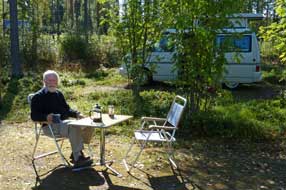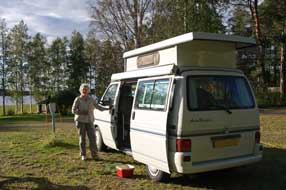|
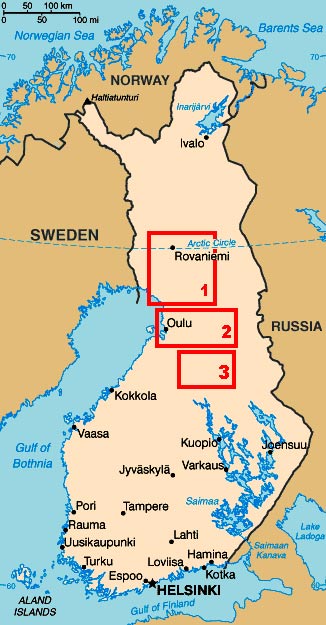 CAMPING
IN FINLAND 2015: Rovaniemi, Napapiiri Hiking Area, Kemijärvi, Auttiköngäs, Ranua,
Pudasjärvi, Oulu, Liminka Bay, Puolanka, Hepoköngäs, Ristijärvi, Sotkamo, Vuokatti, and
Kajaani: CAMPING
IN FINLAND 2015: Rovaniemi, Napapiiri Hiking Area, Kemijärvi, Auttiköngäs, Ranua,
Pudasjärvi, Oulu, Liminka Bay, Puolanka, Hepoköngäs, Ristijärvi, Sotkamo, Vuokatti, and
Kajaani:
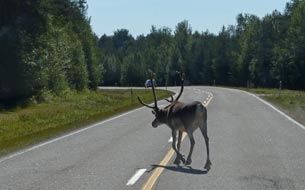 South from Kittilä to Rovaniemi: Route 79 south from Kittilä
followed the valley of the now wide and gently-flowing Ounasjoki through pine
and spruce forest, delightful countryside on a bright, sunny morning. Despite
being a main road traffic was light, but the greater hazard was reindeer
wandering across the carriageway (Photo 1 - Reindeer road hazard).
Where the main road turned sharp right across the Ounasjoki, we continued ahead
onto Route 934 along the river's left bank still through forested terrain for a
further 60 kms; part-way along we crossed the line of the Arctic Circle (Napapiiri
in Finnish), though being a minor road there was no indication. Approaching the
northern outskirts of Rovaniemi, just at the point where the Ounasjoki merged
into the Kemijoki, we turned onto the Route 4 dual-carriageway. After weeks of
peaceful Arctic back-roads, we were pitched suddenly into speeding urban traffic
along this busy stretch of Route 4, speed cameras and all (click on Map 1 right
for details of our journey south). South from Kittilä to Rovaniemi: Route 79 south from Kittilä
followed the valley of the now wide and gently-flowing Ounasjoki through pine
and spruce forest, delightful countryside on a bright, sunny morning. Despite
being a main road traffic was light, but the greater hazard was reindeer
wandering across the carriageway (Photo 1 - Reindeer road hazard).
Where the main road turned sharp right across the Ounasjoki, we continued ahead
onto Route 934 along the river's left bank still through forested terrain for a
further 60 kms; part-way along we crossed the line of the Arctic Circle (Napapiiri
in Finnish), though being a minor road there was no indication. Approaching the
northern outskirts of Rovaniemi, just at the point where the Ounasjoki merged
into the Kemijoki, we turned onto the Route 4 dual-carriageway. After weeks of
peaceful Arctic back-roads, we were pitched suddenly into speeding urban traffic
along this busy stretch of Route 4, speed cameras and all (click on Map 1 right
for details of our journey south).
|
Click on 3 highlighted areas of map
for
details of
Northern Finland |
 |
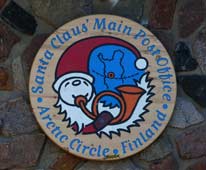 A visit to Santa Claus
at Rovaniemi: 6
kms further, we pulled into the commercial park of the Santa Claus Village (Joulupukin
Pajkylä), indicated by an archway across the road to symbolise its setting on
the notional line of the Arctic Circe; the actual line has long since drifted
away northwards perhaps
repelled by the hoards of A visit to Santa Claus
at Rovaniemi: 6
kms further, we pulled into the commercial park of the Santa Claus Village (Joulupukin
Pajkylä), indicated by an archway across the road to symbolise its setting on
the notional line of the Arctic Circe; the actual line has long since drifted
away northwards perhaps
repelled by the hoards of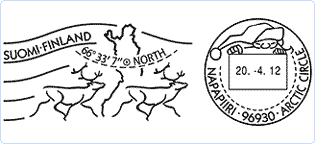 tourists who flock here by the plane- and bus-load to
spend their money. We had 2 reasons for stopping off at this unlikely place: the
first was to take advantage of the novel and modestly un-commercialised service
offered by the Finnish Postal Service at Santa's Main Post Office (see left),
and secondly to pay a return visit to the Great Man himself at his Lapland HQ.
Across the car park, at Santa's Main Post Office (Joulupukin Pääposti),
one of the smilingly charming elves assured
us
that we could still buy our card, write it at the writing tables provided, buy a
stamp at the counter, and post it in the specially provided posting-box for
delivery at Christmas duly franked with Santa's Arctic Circle postmark (see
right); all this for the price of an ordinary stamp. tourists who flock here by the plane- and bus-load to
spend their money. We had 2 reasons for stopping off at this unlikely place: the
first was to take advantage of the novel and modestly un-commercialised service
offered by the Finnish Postal Service at Santa's Main Post Office (see left),
and secondly to pay a return visit to the Great Man himself at his Lapland HQ.
Across the car park, at Santa's Main Post Office (Joulupukin Pääposti),
one of the smilingly charming elves assured
us
that we could still buy our card, write it at the writing tables provided, buy a
stamp at the counter, and post it in the specially provided posting-box for
delivery at Christmas duly franked with Santa's Arctic Circle postmark (see
right); all this for the price of an ordinary stamp.
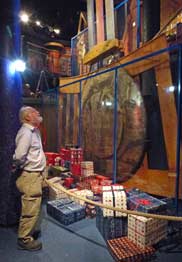 We chose our card, wrote
our message as if from Santa to our granddaughters (in Grandpa's disguised
hand-writing!), and posted it in the Christmas box. And sure enough in
mid-December, it was duly delivered to our granddaughters in Devon; now how
could even sceptically disbelieving 10 and 8 year olds fail to be convinced of
Santa's existence when they unexpectedly receive a personal greeting from the Great
Man
himself! We chose our card, wrote
our message as if from Santa to our granddaughters (in Grandpa's disguised
hand-writing!), and posted it in the Christmas box. And sure enough in
mid-December, it was duly delivered to our granddaughters in Devon; now how
could even sceptically disbelieving 10 and 8 year olds fail to be convinced of
Santa's existence when they unexpectedly receive a personal greeting from the Great
Man
himself!
Across to Santa's Office, we pushed open the
heavy outer door and threaded our way around the mysterious maze of the darkened
interior, past the foot of the Earth-slowing, ticking clock mechanism which, so
the story goes, magically enables Santa to fit his round-the-world presents
delivery travels all in the space of Christmas Eve (see left). So if you had
ever wondered, that's how He does it! A visit to Santa is entirely free of
charge, and at this time of year, with the sun shining and temperature outside
at 23°C, the place was deserted. Hesitantly we climbed the stairs to be admitted
to His chamber by one of His attendant elves. And there the Great Man sat,
beckoning us over to sit with Him each side of his throne. We chatted about our
travels around His native country of Finland, about the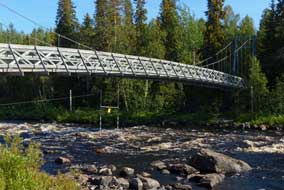 linguistic requirements of His job, (He spoke with us in charmingly accented English), and about our
wish for our visit to bring credibility to His existence in the eyes of our
growing granddaughters. Our audience with the Great Man was all very civilised
and unrushed. We said our farewells with a shake of His hand, and the elf
expressed no surprise that we tactfully declined to part with €25 for an official
photo of our audience! Our re-visit to Santa's HQ had been a happy one: despite
all the accompanying tackiness of Santa Claus Village, the Main Event with a
chance to sit and chat with the Great Man himself, and to post our card for
Christmas delivery from His Main Post-Office, was all low-key and without
charge, with no pressure whatsoever to buy the over-priced photos. You could
take or leave the souvenir shops crammed with racks of tasteless ephemera, and
simply enjoy the magic of a remarkably un-commercialised
visit to Father Christmas. And of course, we did just that! linguistic requirements of His job, (He spoke with us in charmingly accented English), and about our
wish for our visit to bring credibility to His existence in the eyes of our
growing granddaughters. Our audience with the Great Man was all very civilised
and unrushed. We said our farewells with a shake of His hand, and the elf
expressed no surprise that we tactfully declined to part with €25 for an official
photo of our audience! Our re-visit to Santa's HQ had been a happy one: despite
all the accompanying tackiness of Santa Claus Village, the Main Event with a
chance to sit and chat with the Great Man himself, and to post our card for
Christmas delivery from His Main Post-Office, was all low-key and without
charge, with no pressure whatsoever to buy the over-priced photos. You could
take or leave the souvenir shops crammed with racks of tasteless ephemera, and
simply enjoy the magic of a remarkably un-commercialised
visit to Father Christmas. And of course, we did just that!
A wild-camp at Vikaköngäs in the Arctic
Circle Hiking Area: we re-joined the speeding traffic on Route 4 for the 20 kms drive to the
Arctic Circle Hiking Area (Napapiiri Retkeilyalue), a newly designated
nature reserve which we discovered on the excellent Metsähallitus web site www.outdoors.fi
The area promised
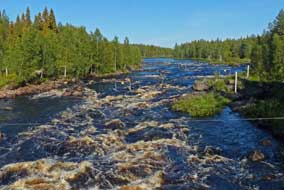 some good walking opportunities, and since
both the Rovaniemi
campsites were ludicrously over-priced, we hoped to find a quiet spot for a
wild-camp. We pulled into the Vikaköngäs parking area alongside the Vikaköngäs
rapids, with its white-water slalom canoe course marked out under the footbridge
(see above right). A board-walk led alongside the rapids to a cluster of
laavu-huts and camp-fire hearth with log-store. This river-side spot overlooking
the Vikaköngäs rapids seemed a perfect wild-camp spot, tucked well away from the
road with the roar of the river-rapids to drown some good walking opportunities, and since
both the Rovaniemi
campsites were ludicrously over-priced, we hoped to find a quiet spot for a
wild-camp. We pulled into the Vikaköngäs parking area alongside the Vikaköngäs
rapids, with its white-water slalom canoe course marked out under the footbridge
(see above right). A board-walk led alongside the rapids to a cluster of
laavu-huts and camp-fire hearth with log-store. This river-side spot overlooking
the Vikaköngäs rapids seemed a perfect wild-camp spot, tucked well away from the
road with the roar of the river-rapids to drown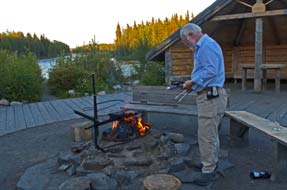 out any traffic noise, and we
could light a camp-fire for a grilled sausage supper. The Arctic Circle Hiking
Area is centred on the rapids of the Raudanjoki river, a tributary of the
Kemijoki. The hilly and marshy terrain has both managed forests and areas of
wilderness forest and several nature trails. Between 19~20th centuries, the
river had been used for log-floating, and when this ended in 1980s, the
log-storage basin area at Vikaköngäs was converted for recreational usage; it
was here that we now camped
(Photo 2 - Vikaköngäs rapids).
That evening we joined a couple from Rovaniemi who were fishing at Vikaköngäs
for a camp-fire (see right); when they went off to resume their fishing, we grilled our
sausages and sat under the kota-shelter for supper, and when the swarming midges
became too bothersome as the sun set, we retired to the camper looking out along
the river with the sound of the rapids filling the air
(Photo 3 - Vikaköngäs wild-camp)
(see below left). out any traffic noise, and we
could light a camp-fire for a grilled sausage supper. The Arctic Circle Hiking
Area is centred on the rapids of the Raudanjoki river, a tributary of the
Kemijoki. The hilly and marshy terrain has both managed forests and areas of
wilderness forest and several nature trails. Between 19~20th centuries, the
river had been used for log-floating, and when this ended in 1980s, the
log-storage basin area at Vikaköngäs was converted for recreational usage; it
was here that we now camped
(Photo 2 - Vikaköngäs rapids).
That evening we joined a couple from Rovaniemi who were fishing at Vikaköngäs
for a camp-fire (see right); when they went off to resume their fishing, we grilled our
sausages and sat under the kota-shelter for supper, and when the swarming midges
became too bothersome as the sun set, we retired to the camper looking out along
the river with the sound of the rapids filling the air
(Photo 3 - Vikaköngäs wild-camp)
(see below left).
We
woke on a bright, sunny morning to find a small tent had been pitched during the
night alongside us on the river-side wide board-walk. It turned out to be a
Russian family who yesterday had crossed the border into Finland near to Ivalo,
from their home in the Murmansk district, and had driven
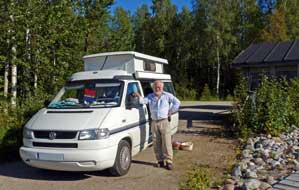 all the
way down here to arrive and camp during the night; they were on their way to
Sweden to fly for a week's holiday in Malta! Their English was limited, and our
Russian almost non-existent, but we managed to converse about their adventurous
trip. all the
way down here to arrive and camp during the night; they were on their way to
Sweden to fly for a week's holiday in Malta! Their English was limited, and our
Russian almost non-existent, but we managed to converse about their adventurous
trip.
Könkäänsaari Nature Trail at Vaattunkiköngäs
Rapids: this
morning we drove back to the parking area at Vaattunkiköngäs to walk the short
nature trail board-walk around Könkäänsaari river-island (Click here for map of Könkäänsaari Island Nature Trail).
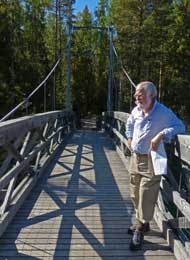 The foot-bridge
leading over to the island gave a spectacular view along the length of the rapids
with the peaty waters and surging currents sparkling in the bright sunlight (see
right)
(Photo 4 - Vaattunkiköngäs Rapids).
The boarded nature trail passed through dark, dense woodland with sunlight
streaking down through the trees (see below left). But after this dramatic start, it became something of an anticlimax:
despite attempts to give some interest with information panels, at this time of
year there was little to be seen by way of plant or bird-life. Part-way round, a
wooden bridge led across to a smaller trail-circuit through the lush vegetation
of Kielosaari island. Potentially this was the most interesting section of the
walk, but the board-walk was in a dilapidated and entirely neglected state. The foot-bridge
leading over to the island gave a spectacular view along the length of the rapids
with the peaty waters and surging currents sparkling in the bright sunlight (see
right)
(Photo 4 - Vaattunkiköngäs Rapids).
The boarded nature trail passed through dark, dense woodland with sunlight
streaking down through the trees (see below left). But after this dramatic start, it became something of an anticlimax:
despite attempts to give some interest with information panels, at this time of
year there was little to be seen by way of plant or bird-life. Part-way round, a
wooden bridge led across to a smaller trail-circuit through the lush vegetation
of Kielosaari island. Potentially this was the most interesting section of the
walk, but the board-walk was in a dilapidated and entirely neglected state.
Könkäänvaara Hill Nature Trail:
after this disappointing start to the day, we returned around the approach lane
to the Makialampi parking area by the main road, and there booted up to walk
what we hoped would be the more interesting circuit and summit of Könkäänvaara
Hill
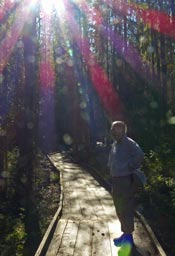 (Click here for map of Könkäänvaara Hill Nature Trail).
Despite having a detailed map, from the start we failed to take note of a
crucial marker, the power-line which indicated the point at which our path
circuit over the hill-top branched off from a cross-country snow-mobile route.
The path initially gained a little height up through the forest as expected but
was quite marshy. We blithely continued ahead, following the line of snow-mobile
route-marker crosses which should have alerted us that we were off
course. It was only when the route began loosing height that things seemed
amiss: we were heading away from our planned route, and not having brought a
day-sac for a relatively short walk, we did not have a compass with us. There
was nothing for it but to retrace our steps, back the way we had come, with
seemingly no trace whatsoever of any path turning up to the densely wooded
hill-top. It was only when we were almost back down to the parking area that we
spotted the power line, and an orange-topped marker-post indicating the paths
junction; we had been following a snow-mobile track and had missed our paths
junction completely, having failed to take note of the power-line key indicator.
Chastened by such elementary carelessness, we turned uphill. Everything now made
sense and fitted the map. (Click here for map of Könkäänvaara Hill Nature Trail).
Despite having a detailed map, from the start we failed to take note of a
crucial marker, the power-line which indicated the point at which our path
circuit over the hill-top branched off from a cross-country snow-mobile route.
The path initially gained a little height up through the forest as expected but
was quite marshy. We blithely continued ahead, following the line of snow-mobile
route-marker crosses which should have alerted us that we were off
course. It was only when the route began loosing height that things seemed
amiss: we were heading away from our planned route, and not having brought a
day-sac for a relatively short walk, we did not have a compass with us. There
was nothing for it but to retrace our steps, back the way we had come, with
seemingly no trace whatsoever of any path turning up to the densely wooded
hill-top. It was only when we were almost back down to the parking area that we
spotted the power line, and an orange-topped marker-post indicating the paths
junction; we had been following a snow-mobile track and had missed our paths
junction completely, having failed to take note of the power-line key indicator.
Chastened by such elementary carelessness, we turned uphill. Everything now made
sense and fitted the map.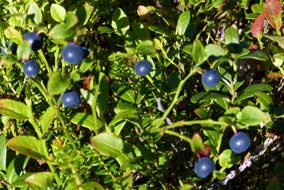
A narrow path headed uphill, with clear
orange-topped post way-marks, through the forest; in 200m this reached another
crucial paths junction duly sign-posted, from where our path contoured around
the hill under a craggy escarpment. This emerged from the forested lower slopes and
up onto the more open rocky ground of the summit plateau through thinly spread
old growth pine forest. Between the lichen-covered rocky slabs, the dense
Bilberry ground-cover was laden with ripe fruit. We had not thought to bring a
plastic pot, so today instead of berry-picking, we gathered and eat the
Bilberries as we walked (see right). We were thankful for the way-marks as the
path wandered every-which-way, looping around the southern side of the summit
plateau, gradually gaining height up onto the highest point. From the summit
marker, the distant views stretched away northward over densely forested
landscape
(Photo 5 - Könkäänvaara Hill).
From the high-point an indistinct line of path threaded in a broadly
south-easterly direction, losing height through the berry-laden Bilberry
ground-cover, to reach the junction for the path looping back around the
hill-side and finally down to the parking area, a pleasant stroll knee-deep in
Bilberry plants with fruit ripe of picking.
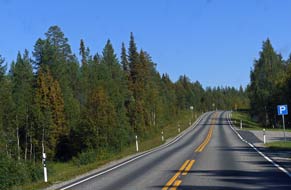 Route
82 to Kemijärvi and fungal-infected sickly spruce trees: from
Makialampi parking area, we set off for the 60 km drive on Route 82 to Kemijärvi.
The road initially ran north-easterly, again crossing the line of the Arctic
Circle, through delightfully rolling, densely forested terrain. But over the last
couple of days, we had noticed that all of the spruces were now consistently
showing a yellowing of their needles, which when brushed shed a pollen-like
dust. This turned out to be a fungal infection called Spruce Needle Rust. The
fungus lives for half its life cycle on spruce needles and the rest of the year
on ground plants of the heather family including Lingonberry and Labrador-tea.
These release fungal spores which, particularly in cool,
wet summers as this year, infect the young growing-tips of spruce needles, and
the fungus develops Route
82 to Kemijärvi and fungal-infected sickly spruce trees: from
Makialampi parking area, we set off for the 60 km drive on Route 82 to Kemijärvi.
The road initially ran north-easterly, again crossing the line of the Arctic
Circle, through delightfully rolling, densely forested terrain. But over the last
couple of days, we had noticed that all of the spruces were now consistently
showing a yellowing of their needles, which when brushed shed a pollen-like
dust. This turned out to be a fungal infection called Spruce Needle Rust. The
fungus lives for half its life cycle on spruce needles and the rest of the year
on ground plants of the heather family including Lingonberry and Labrador-tea.
These release fungal spores which, particularly in cool,
wet summers as this year, infect the young growing-tips of spruce needles, and
the fungus develops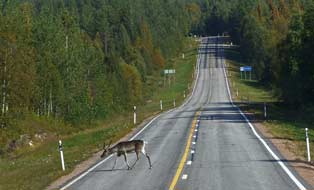 over the summer months. The spruce needles at the
growing-tips turn yellow as tube-like projections form on the infected needles,
releasing powdery spores which re-infect the heather-plant ground-cover,
continuing the fungus' life-cycle. Severely infected spruce trees develop a tan
colour, and the infected needles die and fall off. The impact of this fungal
infection on spruces is said to be purely cosmetic, but since it affects the
young growing needles, it must be damaging, causing defoliation, disfigurement
and reduced growth. We had seen the yellowing effect of the fungal infection on
wholesale masses of spruce trees, both large and small, so its impact was
wide-spread on entire forests. On the drive down to Kemijärvi over pine and
spruce forested hills (see left and right), we saw much evidence of Spruce
Needle Rust. We had not noticed it on such a scale in previous summers, so
perhaps this year's cooler weather had made the fungal infestation far more
prevalent.
over the summer months. The spruce needles at the
growing-tips turn yellow as tube-like projections form on the infected needles,
releasing powdery spores which re-infect the heather-plant ground-cover,
continuing the fungus' life-cycle. Severely infected spruce trees develop a tan
colour, and the infected needles die and fall off. The impact of this fungal
infection on spruces is said to be purely cosmetic, but since it affects the
young growing needles, it must be damaging, causing defoliation, disfigurement
and reduced growth. We had seen the yellowing effect of the fungal infection on
wholesale masses of spruce trees, both large and small, so its impact was
wide-spread on entire forests. On the drive down to Kemijärvi over pine and
spruce forested hills (see left and right), we saw much evidence of Spruce
Needle Rust. We had not noticed it on such a scale in previous summers, so
perhaps this year's cooler weather had made the fungal infestation far more
prevalent.
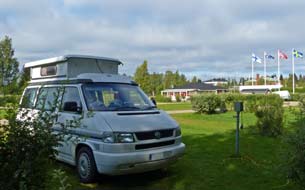 Kemijärvi Camping:
reaching the
outskirts of Kemijärvi, we turned into Kemijärvi Camping on the lake shore (see
left). This had been an expensive site in 2012,
but today prices had risen even more to €30/night, giving the place the
dishonour of being the most expensive campsite in Finland; although a pleasantly turfed site with hedged pitches, we shall not be returning! When we stayed in
July 3 years ago, we had experienced our first Midnight Sun; tonight in late
August the sun
declined much further round to the west and set at 10-0pm with a ruddy glow. The
following morning we took a leisurely pace with our morning jobs; the sun was
just Kemijärvi Camping:
reaching the
outskirts of Kemijärvi, we turned into Kemijärvi Camping on the lake shore (see
left). This had been an expensive site in 2012,
but today prices had risen even more to €30/night, giving the place the
dishonour of being the most expensive campsite in Finland; although a pleasantly turfed site with hedged pitches, we shall not be returning! When we stayed in
July 3 years ago, we had experienced our first Midnight Sun; tonight in late
August the sun
declined much further round to the west and set at 10-0pm with a ruddy glow. The
following morning we took a leisurely pace with our morning jobs; the sun was
just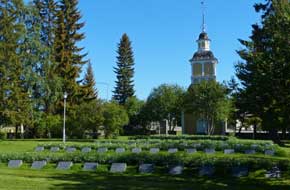 beginning to break through, and fieldfares pecked around the dewy grass
(Photo
6 - Fieldfare pecking in dewy grass). beginning to break through, and fieldfares pecked around the dewy grass
(Photo
6 - Fieldfare pecking in dewy grass).
Kemijärvi Church and war cemetery:
after shopping for provisions at the K-Market, we walked into the town, along the
main street to re-visit Kemijärvi Church. The original wooden church had been
destroyed, along with the rest of the town, in late 1944 by retreating Germans,
and the present modern church was built in 1951. The war cemetery amid carefully
tended lawns between the church and separate bell-tower was filled with the graves of men and women from Lapland killed in the Winter and Continuation Wars
of 1939~44 (see right). Back along through the town, Sheila tried at a
hairdressers to get a haircut; despite the fact that the shop was deserted of
customers and the woman standing around idly, she was far too busy to fit us in
today; tomorrow, she said indifferently!
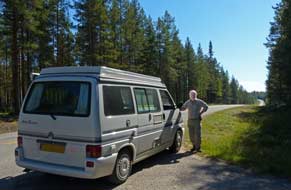 A
welcoming return to Matkatupa Camping: leaving Kemijärvi, we set off
to drive the 26 kms south through the forests to Matkatupa Camping. The
forest floor was littered with boulders, as if the retreating glaciers that had
gouged out the hollows later filled by Kemijärvi lake had deposited an extra
load for its efforts around here. 20 kms further, at N66.562504 - E27.252789, we
reached the line of Napapiiri, the Arctic Circle for our southward
crossing after 6 weeks this year within the Arctic region; here we paused for
photographs A
welcoming return to Matkatupa Camping: leaving Kemijärvi, we set off
to drive the 26 kms south through the forests to Matkatupa Camping. The
forest floor was littered with boulders, as if the retreating glaciers that had
gouged out the hollows later filled by Kemijärvi lake had deposited an extra
load for its efforts around here. 20 kms further, at N66.562504 - E27.252789, we
reached the line of Napapiiri, the Arctic Circle for our southward
crossing after 6 weeks this year within the Arctic region; here we paused for
photographs
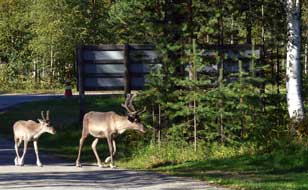 (Photo
7 - Crossing the Arctic Circle). Just beyond we turned into Matkatupa
Camping, and again were welcomed with kindly and charming grace by Urho and Elvi,
the owners. Matkatupa is in a beautiful setting alongside Kemijärvi lake, with
Elvi and Urho's house forming one side of a floral courtyard. The campsite is
set on Urho's farm which had been established from virgin forest by his father
on return from the war. Urho and his brother Paavo had been born here and grew
up on the farm; they still keep a few dairy cattle and work in forestry, cutting
timber and clearing more land, but their main livelihood now is the campsite
developed over the last 40 years. Urho walked around with us helping us chose a
spot to camp; down by the lake was tempting by his outdoor theatre (there had
been 5 shows this summer, he told us proudly), but the ground was still wet.
With the sun now quite hot and blackfly swarming intensely, we pitched in the
shade under the birches behind the café within wi-fi range. As always at Matkatupa,
reindeer wandered past grazing the lawns (see right). We were looking forward to
our day in camp tomorrow in this lovely setting. (Photo
7 - Crossing the Arctic Circle). Just beyond we turned into Matkatupa
Camping, and again were welcomed with kindly and charming grace by Urho and Elvi,
the owners. Matkatupa is in a beautiful setting alongside Kemijärvi lake, with
Elvi and Urho's house forming one side of a floral courtyard. The campsite is
set on Urho's farm which had been established from virgin forest by his father
on return from the war. Urho and his brother Paavo had been born here and grew
up on the farm; they still keep a few dairy cattle and work in forestry, cutting
timber and clearing more land, but their main livelihood now is the campsite
developed over the last 40 years. Urho walked around with us helping us chose a
spot to camp; down by the lake was tempting by his outdoor theatre (there had
been 5 shows this summer, he told us proudly), but the ground was still wet.
With the sun now quite hot and blackfly swarming intensely, we pitched in the
shade under the birches behind the café within wi-fi range. As always at Matkatupa,
reindeer wandered past grazing the lawns (see right). We were looking forward to
our day in camp tomorrow in this lovely setting.
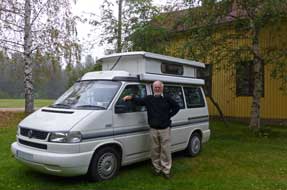 The
following morning, a heavy mist hung over the lake with the autumnal smell of
mouldering leaves filling the damp air (see left). Sheila put on a load of
laundry in the campsite washing machine, while Paul chatted with Urho by the
log-splitting machine and helped load logs into the winter fuel store. The
following morning, a heavy mist hung over the lake with the autumnal smell of
mouldering leaves filling the damp air (see left). Sheila put on a load of
laundry in the campsite washing machine, while Paul chatted with Urho by the
log-splitting machine and helped load logs into the winter fuel store.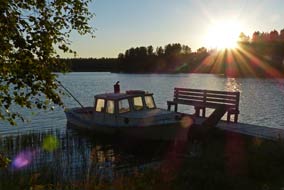 Amid swarming blackfly we strung a washing line between trees down by the lake
but with the sky still overcast and sun struggling to break through, the washing
was unlikely to dry. The sun set across the lake (see right), and by 9-45pm it
was almost dark.
Amid swarming blackfly we strung a washing line between trees down by the lake
but with the sky still overcast and sun struggling to break through, the washing
was unlikely to dry. The sun set across the lake (see right), and by 9-45pm it
was almost dark.
Auttiköngäs Nature Trail: after farewell photos for another year with
Urho and Elvi on the steps of the Matkatupa café (Photo
8 - Farewell to Matkatupa), we continued along
Route 944 through the forested Kemijärvi landscape, all the spruces
looking sickly yellow with rust fungal infestation. Beyond Autti, we turned east
onto Route 81, and with the morning cloud just beginning to break, we reached
the turning into the rough gravel lane leading down to the Auttiköngäs café and start of the Auttiköngäs Nature Trail. Booting up and today taking plastic pots in anticipation of
Bilberry picking, we set off down to Auttiköngäs waterfalls and gorge and the nature trail circuit (Click here for map of Auttiköngäs Nature Trail).
The Auttijoki river, long an east~west trade route, had been used from the late
19th century as a log-floating route into the Kemijoki and down to the sawmills
at Kemi at the head of the Bothnian Gulf. To negotiate the otherwise
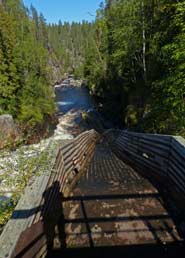 impassable
16m high waterfalls and rapids at Auttiköngäs, a log-flume had been constructed
alongside the cascade for logs to be floated down into the ongoing lower gorge,
with a dam and sluice gates at the top to build up a head of water for the
flume. impassable
16m high waterfalls and rapids at Auttiköngäs, a log-flume had been constructed
alongside the cascade for logs to be floated down into the ongoing lower gorge,
with a dam and sluice gates at the top to build up a head of water for the
flume.
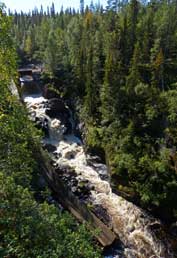 From the footbridge over the dam, the morning
sunshine lit the whole length of the log-flume alongside the cascading Auttiköngäs
falls, the sheer rocky side-walls of the enclosing gorge, and surrounding
forested fells (Photo
9 - Auttiköngäs log-flume), and a dipper was hopping around on the
lower bridge stanchion. We now discovered the meaning of the notice at the gate alerting walkers to path maintenance: Metsähallitus
were re-building the steps at the far side of the dam-bridge where the path
mounted a steep bank. Fortunately a temporary path bypassed the taped-off area
leading up the slope to reach the on-going path along the rim of the gorge. The
gorge-top path was newly made up with airy view down into the gorge to the falls and flume
(see right)
(Photo
10 - Auttiköngäs gorge and falls). The board-walk path dropped down on steps
to bridge a side-gulley filled with a tangle of huge boulders which had been
spilled down into the gulley by torrents of glacial melt-waters (see below left). The force of
water to have washed down boulders of this size was staggering. The path shelved
along the far side above the forested gorge to reach a high look-out point. This
airy position clear of the trees meant relief from the swarming blackfly for us
to sit for our sandwiches. From here we could look across the gorge to the densely
forested hill-side of Könkäänvaara opposite where, amid the dark green mass of pines, the
yellow, rust-infested spruces stood out distinctly; close-up photos of infected
spruce branches on our side of the gorge showed the fungal spore producing tube-like
projections on the needle growing-tips
(Photo
11 - Rust infected spruce). From the footbridge over the dam, the morning
sunshine lit the whole length of the log-flume alongside the cascading Auttiköngäs
falls, the sheer rocky side-walls of the enclosing gorge, and surrounding
forested fells (Photo
9 - Auttiköngäs log-flume), and a dipper was hopping around on the
lower bridge stanchion. We now discovered the meaning of the notice at the gate alerting walkers to path maintenance: Metsähallitus
were re-building the steps at the far side of the dam-bridge where the path
mounted a steep bank. Fortunately a temporary path bypassed the taped-off area
leading up the slope to reach the on-going path along the rim of the gorge. The
gorge-top path was newly made up with airy view down into the gorge to the falls and flume
(see right)
(Photo
10 - Auttiköngäs gorge and falls). The board-walk path dropped down on steps
to bridge a side-gulley filled with a tangle of huge boulders which had been
spilled down into the gulley by torrents of glacial melt-waters (see below left). The force of
water to have washed down boulders of this size was staggering. The path shelved
along the far side above the forested gorge to reach a high look-out point. This
airy position clear of the trees meant relief from the swarming blackfly for us
to sit for our sandwiches. From here we could look across the gorge to the densely
forested hill-side of Könkäänvaara opposite where, amid the dark green mass of pines, the
yellow, rust-infested spruces stood out distinctly; close-up photos of infected
spruce branches on our side of the gorge showed the fungal spore producing tube-like
projections on the needle growing-tips
(Photo
11 - Rust infected spruce).
We made frequent Bilberry-picking stops along
the next stretch through the forest until the path dropped down to reach the
laavu-hut by the rickety suspension-bridge spanning the Auttijoki river; this
now had lost all the force of torrent which had cascaded down the higher gorge
and here was almost stagnant. Across the bridge, we began climbing the wooden
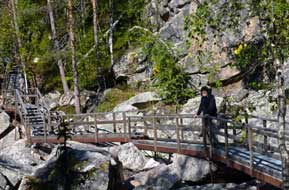 steps up the steep, forested hill-side. Here the forest floor was covered with a
lush carpet of Bilberry laden with fruit ripe for picking as we climbed the
slope. Further steps mounted the hill-side's next rocky tier, and the on-going
path now passed several huge erratic boulders, finally reaching the rocky slabbed summit plateau of Könkäänvaara hill with its observation tower (see
right). From the
tower's observation platform, we could look out over the distant forested
landscape with the yellow rust-infested spruces standing out clearly amid the
sea of dark green pines
(Photo
12 - Rust-infested spruces on Könkäänvaara). Beginning the descent
from Könkäänvaara summit plateau, we picked up the line of board-walk path down
the steep hill slope. Here the Bilberry ground-cover was the lushest we had seen
all day steps up the steep, forested hill-side. Here the forest floor was covered with a
lush carpet of Bilberry laden with fruit ripe for picking as we climbed the
slope. Further steps mounted the hill-side's next rocky tier, and the on-going
path now passed several huge erratic boulders, finally reaching the rocky slabbed summit plateau of Könkäänvaara hill with its observation tower (see
right). From the
tower's observation platform, we could look out over the distant forested
landscape with the yellow rust-infested spruces standing out clearly amid the
sea of dark green pines
(Photo
12 - Rust-infested spruces on Könkäänvaara). Beginning the descent
from Könkäänvaara summit plateau, we picked up the line of board-walk path down
the steep hill slope. Here the Bilberry ground-cover was the lushest we had seen
all day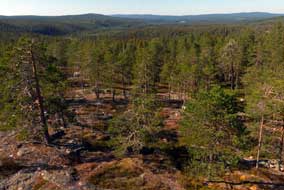 and the plants laden with ripe berries. Despite the swarming blackfly, we filled
our berry-picking pots as we descended the forested slope to the parking area.
On the descent, we passed a series of young spruces, like baby Christmas trees,
totally infected and discoloured by rust fungus; it was a tragic sight.
and the plants laden with ripe berries. Despite the swarming blackfly, we filled
our berry-picking pots as we descended the forested slope to the parking area.
On the descent, we passed a series of young spruces, like baby Christmas trees,
totally infected and discoloured by rust fungus; it was a tragic sight.
South to Ranua and a closed campsite: we return westward on Route 81,
and beyond Autti, turned off south on Route 942 for the 60 kms drive to Ranua.
Initially forested, this lovely road became more pastoral as we drove south,
passing farms with pastureland recently cut for silage. We also passed many
young spruces all totally yellow with rust infestation; it was along this road
that we also first noticed a yellow scum at lake-side shallows, which we decided
must be concentrated rust fungus spores floating on the stagnant water surface.
In bright afternoon sunshine we eventually reached Ranua, pausing at
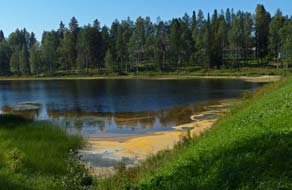 the
S-Market for provisions. It was only a short distance out of the village to our
planned campsite Ranuajärvi Camping, a pleasant site used in 2012, under pines on
the shore of its eponymous lake. As we passed Ranuajärvi, we noticed more of the
yellow fungus spore scum floating in the shallows (see left). We turned off to
the campsite, looking forward to settling in after a long day - but disaster!
The gate was locked, and site closed, whether permanently was unclear, but a
sign said it had closed early in August. There was no option but to use the site
at Ranua Zoo, a new but unimpressive place just the
S-Market for provisions. It was only a short distance out of the village to our
planned campsite Ranuajärvi Camping, a pleasant site used in 2012, under pines on
the shore of its eponymous lake. As we passed Ranuajärvi, we noticed more of the
yellow fungus spore scum floating in the shallows (see left). We turned off to
the campsite, looking forward to settling in after a long day - but disaster!
The gate was locked, and site closed, whether permanently was unclear, but a
sign said it had closed early in August. There was no option but to use the site
at Ranua Zoo, a new but unimpressive place just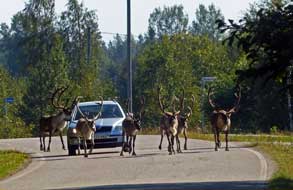 north of the village. It was crammed full with holiday-making caravans and
camping-cars, with all their screaming dogs, yapping kids and materialistic
paraphernalia. Regretting thoroughly the necessity to use such an alien
campsite, we found a corner spot. Determined to make the most of it, we
discovered that their clothes drying-machine was free of charge and used it to finish
drying our bag-loads of semi wet laundry. The peace of a dusky evening was
further disturbed by delinquents from the camping-cars parading their juvenile
inadequacy by hurtling around the campsite yelling, as their even more
inadequate parents made even more noise. What a ghastly place!
north of the village. It was crammed full with holiday-making caravans and
camping-cars, with all their screaming dogs, yapping kids and materialistic
paraphernalia. Regretting thoroughly the necessity to use such an alien
campsite, we found a corner spot. Determined to make the most of it, we
discovered that their clothes drying-machine was free of charge and used it to finish
drying our bag-loads of semi wet laundry. The peace of a dusky evening was
further disturbed by delinquents from the camping-cars parading their juvenile
inadequacy by hurtling around the campsite yelling, as their even more
inadequate parents made even more noise. What a ghastly place!
Leaving Lapland and south to Pudasjärvi: leaving Ranua the following morning (click on Map
1 at top right of page for details of our journey), we took Route 858 SE-wards,
a beautifully peaceful minor road through pine forests with just the occasional
sickly spruce tree, and at the village of
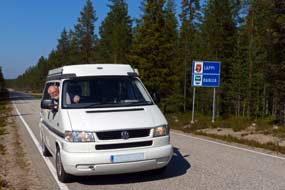 Kelankylä we paused as a final
symbolic herd of reindeer ambled past
(Photo
13 - Lapland's southernmost reindeer) (see above right); just beyond the village we finally left
Lapland (see left). The road continued through magnificent pine forests lit by
the afternoon sun, and we turned south-westerly on cross-country minor lanes
along the valley of the Livojoki to the village of Yli-Livo. The surrounding
countryside was either farmland or unclaimed marshland indicated by names ending
in -suo. We finally reached the main Route 20 and turned west for the
remaining 7 kms into Pudasjärvi. Major road works on the Iijoki bridge caused
bewilderment in trying to turn off into the village, and after shopping at the
K-Market, we headed out to tonight's campsite just north of Pudasjärvi. Kelankylä we paused as a final
symbolic herd of reindeer ambled past
(Photo
13 - Lapland's southernmost reindeer) (see above right); just beyond the village we finally left
Lapland (see left). The road continued through magnificent pine forests lit by
the afternoon sun, and we turned south-westerly on cross-country minor lanes
along the valley of the Livojoki to the village of Yli-Livo. The surrounding
countryside was either farmland or unclaimed marshland indicated by names ending
in -suo. We finally reached the main Route 20 and turned west for the
remaining 7 kms into Pudasjärvi. Major road works on the Iijoki bridge caused
bewilderment in trying to turn off into the village, and after shopping at the
K-Market, we headed out to tonight's campsite just north of Pudasjärvi.
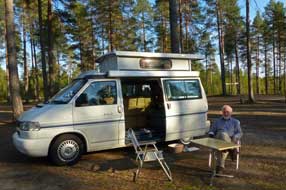 Jyrkkäkoski
Camping at Pudasjärvi: a warm welcome and delightful camping area
among pine woodland had left us with fond memories of our stay at
Jyrkkäkoski Camping in 2012. How things can change in just 3 years! Today we
were greeted in an off-hand manner by the new owner: the charge had increased
inevitably, but the woodland camping area was now the preserve of Thai workers
employed for commercial berry-picking. The now available camping area was in
open woodland with little shade and some 400m from the facilities building, but
we pitched under the trees trying to gauge the least sun heated spot. The
alleged wi-fi signal failed to reach the camping area, and on returning to
reception, we discovered the run-down state of the facilities: 3 years on they
were now grubby, smelly and truly disgusting, some of the worst of the trip, and
it was clear that the Thai workers' recompense for overnight berry-picking at
whatever dubious rates they were paid was Jyrkkäkoski
Camping at Pudasjärvi: a warm welcome and delightful camping area
among pine woodland had left us with fond memories of our stay at
Jyrkkäkoski Camping in 2012. How things can change in just 3 years! Today we
were greeted in an off-hand manner by the new owner: the charge had increased
inevitably, but the woodland camping area was now the preserve of Thai workers
employed for commercial berry-picking. The now available camping area was in
open woodland with little shade and some 400m from the facilities building, but
we pitched under the trees trying to gauge the least sun heated spot. The
alleged wi-fi signal failed to reach the camping area, and on returning to
reception, we discovered the run-down state of the facilities: 3 years on they
were now grubby, smelly and truly disgusting, some of the worst of the trip, and
it was clear that the Thai workers' recompense for overnight berry-picking at
whatever dubious rates they were paid was
 to
base their fast-food stall cooking in the campsite kitchen! But despite the
disappointment of Jyrkkäkoski Camping 2015, we settled in, and for one of the
few times this summer, sat outside to enjoy the early evening sunshine and
comparative absence now of midges (see right). After supper that evening, we lit
a log fire at the camp-fire hearth and sat around this as the sky grew dusky. As
if to add to the offence already caused, the ill-mannered owner came over urging
us not to use too much wood; the log-store was full to overflowing and we
responded by stoking the fire further! to
base their fast-food stall cooking in the campsite kitchen! But despite the
disappointment of Jyrkkäkoski Camping 2015, we settled in, and for one of the
few times this summer, sat outside to enjoy the early evening sunshine and
comparative absence now of midges (see right). After supper that evening, we lit
a log fire at the camp-fire hearth and sat around this as the sky grew dusky. As
if to add to the offence already caused, the ill-mannered owner came over urging
us not to use too much wood; the log-store was full to overflowing and we
responded by stoking the fire further!
In spite of the disappointing changes at
Jyrkkäkoski Camping, we decided to take our planned day in camp here; the
following morning dawned with a truly autumnal feel, the camping area and
surrounding forest filled with chill morning mist. The showers by reception were
simply too disgusting to contemplate, but we discovered that the sauna hut was
not only open but had showers. But when we took the laptop over to reception,
the owner refused to open the common room to let us sit to use the wi-fi; this
was the last straw! The sun did eventually break through to give a pleasantly
warm day, and again we were able to sit outside watching gliders being towed up
by a light aircraft from the nearby airfield (see left). That evening, we again
lit a camp-fire in the covered hearth-place, and sat chatting with some Finns
from Oulu. As the evening grew dark,
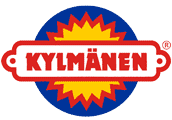 a
huge orange harvest moon rose above the southern horizon. We had enjoyed a
pleasantly relaxing and sunny day in camp under the pines, but the happy
recollections from our 2012 stay at Jyrkkäkoski Camping had been regrettably
soured by its now disgusting facilities and ill-mannered new owner . a
huge orange harvest moon rose above the southern horizon. We had enjoyed a
pleasantly relaxing and sunny day in camp under the pines, but the happy
recollections from our 2012 stay at Jyrkkäkoski Camping had been regrettably
soured by its now disgusting facilities and ill-mannered new owner .
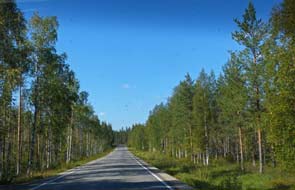 Out to the Bothnian Gulf at Oulu: today we should move westwards
out to the Bothnian Gulf coast at Oulu; a change to rain was forecast for later
in the week, but we hoped that the present sunny weather would last for our day
in what is our favourite city of Northern Finland. But first we drove back into Pudasjärvi
to re-stock with provisions, re-fill
the camper with diesel, and to visit the Pudasjärvi branch of Kylmänen whose
factory-shop we had used at Sodankylä (see right). The shop was well stocked and
we bought packs of elk meat, elk meat-balls and reindeer sausages. Out to the Bothnian Gulf at Oulu: today we should move westwards
out to the Bothnian Gulf coast at Oulu; a change to rain was forecast for later
in the week, but we hoped that the present sunny weather would last for our day
in what is our favourite city of Northern Finland. But first we drove back into Pudasjärvi
to re-stock with provisions, re-fill
the camper with diesel, and to visit the Pudasjärvi branch of Kylmänen whose
factory-shop we had used at Sodankylä (see right). The shop was well stocked and
we bought packs of elk meat, elk meat-balls and reindeer sausages.
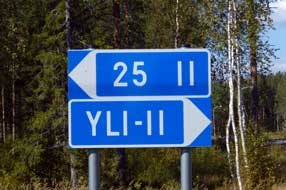 From Pudasjärvi, we turned off westwards
onto Route 855, a peaceful back-road route along the Iijoki valley out to the
Bothnian Gulf coast. We paused at an untranslatable war memorial, probably
recalling the Finns' pursuit of the retreating Germans from Lapland in 1944.
With the sun bright,
this was a delightful road winding through pine and birch woodlands (see left),
with spruce seeming less infected with rust fungus than further north. As we
moved westwards, the continuous forest gave way to increasingly cleared
farmland, and at Tannila we turned SW onto Route 849 through more intensive
farmland to reach the charmingly named village of Yli-Ii, meaning Upper Ii.
Alongside the now wide Iijoki, we drove along the lower valley to cross the
river into Ii village, leading to the junction with the main Route 4/E75 highway.
Suddenly after all the quiet back-lanes of Lapland, we were in busy traffic as
we turned south along the highway, to the small town of Haukipudas, now
virtually a suburb of Oulu, to re-visit the famous Baroque painted parish
church. From Pudasjärvi, we turned off westwards
onto Route 855, a peaceful back-road route along the Iijoki valley out to the
Bothnian Gulf coast. We paused at an untranslatable war memorial, probably
recalling the Finns' pursuit of the retreating Germans from Lapland in 1944.
With the sun bright,
this was a delightful road winding through pine and birch woodlands (see left),
with spruce seeming less infected with rust fungus than further north. As we
moved westwards, the continuous forest gave way to increasingly cleared
farmland, and at Tannila we turned SW onto Route 849 through more intensive
farmland to reach the charmingly named village of Yli-Ii, meaning Upper Ii.
Alongside the now wide Iijoki, we drove along the lower valley to cross the
river into Ii village, leading to the junction with the main Route 4/E75 highway.
Suddenly after all the quiet back-lanes of Lapland, we were in busy traffic as
we turned south along the highway, to the small town of Haukipudas, now
virtually a suburb of Oulu, to re-visit the famous Baroque painted parish
church.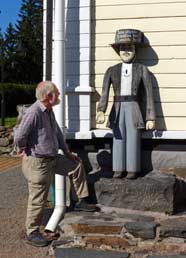
Haukipudas painted church:
the afternoon sun was now hot as we walked over to the church and war cemetery. The squat church with its chamfered
cornered, red-tiled modern roof was built in 1762 on the site of an earlier
church here at the mouth of the Kiiminkijoki river, in the cruciform style
common in Ostrobothnian churches where the congregation was closely gathered
around the pulpit for Lutheran instruction. The church's scale and elaborate
wall paintings show that this must have been a wealthy community: Michael
Toppelius from Oulu, the top church painter of the day, was commissioned to
decorate the church's interior walls with exuberantly Baroque paintings of Old
and New Testament scenes including ornate Passion, Day of Judgement, and
Resurrection depictions. We had been fortunate in 2012 to gain admission to see
the paintings, but today the church was securely locked. We could only
photograph the church exterior from the trimly maintained war cemetery where the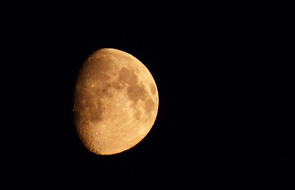 graves of local Winter and Continuation War dead were decorated with
fuschia shrubs (Photo
14 - Haukipudas Church). A wooden pauper statue with collecting-box for
donations of
money for the poor (vaivaisukko in Finnish) stood by the bell-tower (see
left). graves of local Winter and Continuation War dead were decorated with
fuschia shrubs (Photo
14 - Haukipudas Church). A wooden pauper statue with collecting-box for
donations of
money for the poor (vaivaisukko in Finnish) stood by the bell-tower (see
left).
Nallikari Camping at Oulu:
rejoining the E75 highway into the outskirts of Oulu, and thankful for the
sat-nav's guidance, we turned off through the NW suburbs to find Nallikari
Camping. The site mainly serves the summer holiday hoards who swarm to the
Bothnian coast beaches, and being part of the Top Camp chain with a monopolistic
position in Oulu, it has prices to match. Having checked bus times at the
nearby bus terminus for tomorrow's city visit, we now submitted ourselves to Nallikari's bureaucratic and tediously exhausting booking-in process. The
reception staff were pleasantly welcoming, and we dutifully filled out the
lengthy forms. We then had to walk round to the camping areas, select our pitch,
and return to reception to have the number recorded and be issued with gate
code and electric box key. Weary after a long day, it took over half an hour
with all this rigmarole, before we could settle in and relax. But at least
Oulu's city-wide Pan-Oulu wi-fi network enabled us to check the weather
forecast. The sun set, the
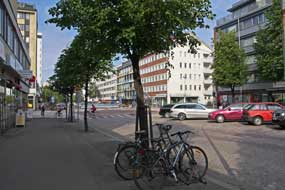 evening grew dark and dewy even earlier, and a
magnificently clear half-moon rose (see right). evening grew dark and dewy even earlier, and a
magnificently clear half-moon rose (see right).
A re-visit to Oulu: another bright,
sunny morning for our re-visit to Oulu (pronounced Oh-loo) (see log of our 2012 visit to Oulu).
With a population of 135,000, Oulu is Northern Finland's largest city. Founded
in 1605 by Swedish King Karl IX as a port at the mouth of the Oulujoki river, the city's historical wealth was based on timber floated down the river from the
forests of Kainuu, salmon fishing in the river, but most particularly on
the export of pine tar brought for caulking wooden sailing ships. A disastrous
fire in 1822 destroyed much of Oulu which was rebuilt in grandiose style by the
city's wealthy merchants who enlisted Carl Ludwig Engel, Helsinki's
architect-in-chief, to design the new city's major public buildings in
neo-Classical style. The modern city has been revitalised in recent years by its
university's technological and computing expertise, attracting IT companies to
establish science and technology parks in the outskirts. Oulu has become a
national leader in the IT and microchip industries, attracting skilled IT
staff from across the world as well as local graduates.
We
walked over for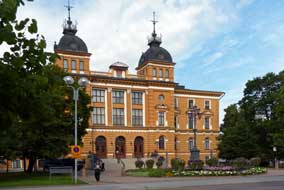 the 10-35am #15 bus; this arrived promptly and, although fares were expensive at €3-30 per passenger journey with no senior's reductions, the
drivers were ultra helpful and polite and the service efficient. We
followed the journey into the city on our city-plan, recalling sights as the bus
approached the centre past the cathedral to stop in Torikatu right outside the
TIC. Paul was hoping to find a solution today for his hors de combat
camera; a helpful member of the TIC staff provided the name and location of a
camera shop which he felt certain would be able to help. We headed through
central Oulu's grid of streets, and found the Oulun Kuva
Camera Shop along Hallituskatu (see left). The lady spoke faultless English, immediately diagnosed the problem
as a faulty lens, and supplied a suitable replacement. Although expensive, Paul was back
in photographic business after a agonizing 10 day gap; we were fortunate to have
found such a good photographic shop, now almost unknown in UK. the 10-35am #15 bus; this arrived promptly and, although fares were expensive at €3-30 per passenger journey with no senior's reductions, the
drivers were ultra helpful and polite and the service efficient. We
followed the journey into the city on our city-plan, recalling sights as the bus
approached the centre past the cathedral to stop in Torikatu right outside the
TIC. Paul was hoping to find a solution today for his hors de combat
camera; a helpful member of the TIC staff provided the name and location of a
camera shop which he felt certain would be able to help. We headed through
central Oulu's grid of streets, and found the Oulun Kuva
Camera Shop along Hallituskatu (see left). The lady spoke faultless English, immediately diagnosed the problem
as a faulty lens, and supplied a suitable replacement. Although expensive, Paul was back
in photographic business after a agonizing 10 day gap; we were fortunate to have
found such a good photographic shop, now almost unknown in UK.
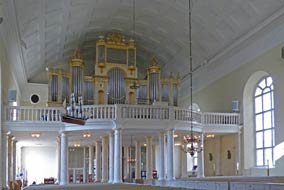 Paul's revitalised camera was put to immediate
use, as we returned along Kirkkokatu to photograph Oulu's grandiose neo-Gothic
City Hall
(see above right) (Photo
15 - Oulu City Hall). The Cathedral's bells had just begun booming out
their noon ringing and we walked up to photograph the interior of Engel's
starkly Lutheran neo-Classical Cathedral (see left), and from the gardens of Franzenin puisto, the ochre-coloured frontage (Photo
16 - Oulu Cathedral). In the gardens to the rear of City Hall, the now
warm sunshine lit the line of diminutive bronze Paul's revitalised camera was put to immediate
use, as we returned along Kirkkokatu to photograph Oulu's grandiose neo-Gothic
City Hall
(see above right) (Photo
15 - Oulu City Hall). The Cathedral's bells had just begun booming out
their noon ringing and we walked up to photograph the interior of Engel's
starkly Lutheran neo-Classical Cathedral (see left), and from the gardens of Franzenin puisto, the ochre-coloured frontage (Photo
16 - Oulu Cathedral). In the gardens to the rear of City Hall, the now
warm sunshine lit the line of diminutive bronze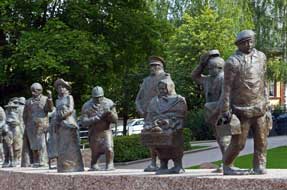 sculpted figures of Sanna
Koivisto's memorial, Ajan Kulku (Course of Time), created in 2005 to
commemorate the 400th anniversary of Oulu's foundation. The wall-top procession
of 32 figures represent characters who had influenced the city's development
over its 400 years history, starting with its founder King Karl IX of Sweden;
the wall-top line of figures include a man rolling a tar barrel, fishermen
holding salmon, a fireman from the 1822 great fire, a mother with children, a
student reading her newspaper, a yuppie clutching his mobile phone, and at the
very front symbolising the future a small boy sits at the end of the wall (Photo
17 - Course of Time memorial). It has become a tradition for locals to wrap the
little figure with knitted scarf and hat to keep him warm in winter. The
engaging line of
bronze figures provided perfect photographic opportunity against the sunlit
backdrop of the neo-Gothic façade of Valve, the city's cultural centre (Photo
18 - Oulu's 400 years of history). sculpted figures of Sanna
Koivisto's memorial, Ajan Kulku (Course of Time), created in 2005 to
commemorate the 400th anniversary of Oulu's foundation. The wall-top procession
of 32 figures represent characters who had influenced the city's development
over its 400 years history, starting with its founder King Karl IX of Sweden;
the wall-top line of figures include a man rolling a tar barrel, fishermen
holding salmon, a fireman from the 1822 great fire, a mother with children, a
student reading her newspaper, a yuppie clutching his mobile phone, and at the
very front symbolising the future a small boy sits at the end of the wall (Photo
17 - Course of Time memorial). It has become a tradition for locals to wrap the
little figure with knitted scarf and hat to keep him warm in winter. The
engaging line of
bronze figures provided perfect photographic opportunity against the sunlit
backdrop of the neo-Gothic façade of Valve, the city's cultural centre (Photo
18 - Oulu's 400 years of history).
 It was time now to head down to the Kauppatori
(Market Square) for lunch, on the way passing the 1901 elegant red-brick
Kauppahalli (Market Hall) (Photo
19 - Oulu's Kauppahalli), and the squat, portly figure of
Toripolisi, the bronze statue of an Oulu market place policeman funded by
public subscription to symbolise the bobby-on-the-beat around the Kauppatori (Photo
20 - Toripolisi statue). Across at the market stalls, we bought
our lunch to eat at the stall's covered seating area
along with Oulu locals (see left), as always enjoying the market ambience and
watching the many local people of all ages cycling around the city's walkways;
given Oulu's unique topography spanning the islands of the Oulujoki delta all
interconnected by footbridges, cycling is the most practicable means of travel
within the city's central It was time now to head down to the Kauppatori
(Market Square) for lunch, on the way passing the 1901 elegant red-brick
Kauppahalli (Market Hall) (Photo
19 - Oulu's Kauppahalli), and the squat, portly figure of
Toripolisi, the bronze statue of an Oulu market place policeman funded by
public subscription to symbolise the bobby-on-the-beat around the Kauppatori (Photo
20 - Toripolisi statue). Across at the market stalls, we bought
our lunch to eat at the stall's covered seating area
along with Oulu locals (see left), as always enjoying the market ambience and
watching the many local people of all ages cycling around the city's walkways;
given Oulu's unique topography spanning the islands of the Oulujoki delta all
interconnected by footbridges, cycling is the most practicable means of travel
within the city's central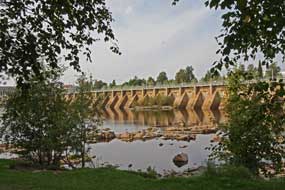 area. After
lunch we walked around the stalls hoping to buy Lingonberries (Pulolukka
in Finnish), but after such a miserable summer, these were not expected to be
ripe for another couple of weeks (Photo
21 - Oulu market). Over to the corner of the open market, we browsed
the stalls of the Covered Market (Kauppahalli) (Photo
22 - Oulu's Kauppahalli), before setting off for our walk around the
Ainola parklands and the islands of the Oulujoki delta. Since 2012, a series of
huge fountains had been installed out in the bay, of dubious aesthetic value and
rather gilding the lily of these magnificent natural surroundings. Along the
waterside, we reached the point from where we could look across at the Merikoski
dam spanning the width of the bay. 25 years in the planning and further delayed
by the wars, the Merikoski dam and power generating plant was finally completed
in 1954, producing 11% of Oulu's electricity requirements (Photo
23 - Merikoski dam). Moving on around the waterside and looking out
across to the dam, we reached the 750m long stepped water passage-way of
the Merikoski fish-ladder (see below left); this was built in 2003 by Oulun
Energia under pressure from environmentalists to create a means for migrating
salmon to return upstream to their natural spawning grounds, by-passing the
dam-barrage which now blocks the river's course. In 2012 we had been fortunate
enough to gain admission to the fish-ladder's underground control room with its
viewing ports enabling underwater view of salmon fighting area. After
lunch we walked around the stalls hoping to buy Lingonberries (Pulolukka
in Finnish), but after such a miserable summer, these were not expected to be
ripe for another couple of weeks (Photo
21 - Oulu market). Over to the corner of the open market, we browsed
the stalls of the Covered Market (Kauppahalli) (Photo
22 - Oulu's Kauppahalli), before setting off for our walk around the
Ainola parklands and the islands of the Oulujoki delta. Since 2012, a series of
huge fountains had been installed out in the bay, of dubious aesthetic value and
rather gilding the lily of these magnificent natural surroundings. Along the
waterside, we reached the point from where we could look across at the Merikoski
dam spanning the width of the bay. 25 years in the planning and further delayed
by the wars, the Merikoski dam and power generating plant was finally completed
in 1954, producing 11% of Oulu's electricity requirements (Photo
23 - Merikoski dam). Moving on around the waterside and looking out
across to the dam, we reached the 750m long stepped water passage-way of
the Merikoski fish-ladder (see below left); this was built in 2003 by Oulun
Energia under pressure from environmentalists to create a means for migrating
salmon to return upstream to their natural spawning grounds, by-passing the
dam-barrage which now blocks the river's course. In 2012 we had been fortunate
enough to gain admission to the fish-ladder's underground control room with its
viewing ports enabling underwater view of salmon fighting
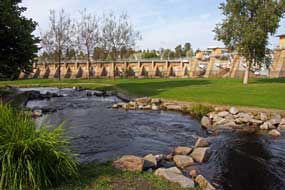 their
way upstream against the current. Today however this was closed and we could
only view the water rushing along the open channel above ground (Photo
24 - Merikoski fish-ladder). their
way upstream against the current. Today however this was closed and we could
only view the water rushing along the open channel above ground (Photo
24 - Merikoski fish-ladder).
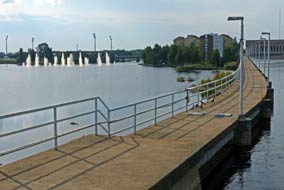 Dodging the processions of speeding cyclists, we
continued across the dam where on our 2012 visit, the sluice-gates had been open
creating a spectacular cascade when viewed from above on the dam pathway and
from a distance across the
parkland. Today there was just the view along the
semi-dry lower area below the dam and the distant artificial fountains over
towards the generating plant (see right) (Photo
25- Merikoski dam). We made our way under shady trees back along the
pathway to the generating station and down to the river-side path on the far
side where the waters emerged from below the power-plant. Over the foot-bridge
across the tip of Kuusiaari Island and past the Raati sports stadium, we crossed
via Linnansaari Island by the scant remains of the Swedish fortress and views
across the water towards Oulu Cathedral (Photo
26- Oulu Cathedral), and back over the bridge to our start-point
in the Kauppatori by the formless block-shaped library and theatre. After a
pause for liquorice ice-cream (the Finns favourite flavour) in the market place, we walked back up to Torikatu for our bus to the Nallikari terminus. Before returning to the
campsite, we walked over to the beach looking out to the Bothnian Gulf, but this
evening the air was hazy with no clear seaward view at all. In the dusk of early
evening, red squirrels hopped around the birches close to where we were camping
(Photo
27- Red Squirrel). Dodging the processions of speeding cyclists, we
continued across the dam where on our 2012 visit, the sluice-gates had been open
creating a spectacular cascade when viewed from above on the dam pathway and
from a distance across the
parkland. Today there was just the view along the
semi-dry lower area below the dam and the distant artificial fountains over
towards the generating plant (see right) (Photo
25- Merikoski dam). We made our way under shady trees back along the
pathway to the generating station and down to the river-side path on the far
side where the waters emerged from below the power-plant. Over the foot-bridge
across the tip of Kuusiaari Island and past the Raati sports stadium, we crossed
via Linnansaari Island by the scant remains of the Swedish fortress and views
across the water towards Oulu Cathedral (Photo
26- Oulu Cathedral), and back over the bridge to our start-point
in the Kauppatori by the formless block-shaped library and theatre. After a
pause for liquorice ice-cream (the Finns favourite flavour) in the market place, we walked back up to Torikatu for our bus to the Nallikari terminus. Before returning to the
campsite, we walked over to the beach looking out to the Bothnian Gulf, but this
evening the air was hazy with no clear seaward view at all. In the dusk of early
evening, red squirrels hopped around the birches close to where we were camping
(Photo
27- Red Squirrel).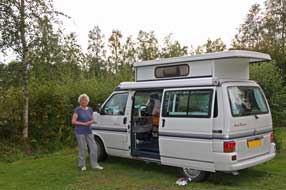
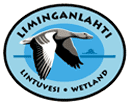 Liminka
Bay wetlands: the forecast rain
arrived during the night and this morning was heavily overcast (see left).
Despite Nallikari's pretentions and its unduly expensive prices, the facilities
were care-worn and lacked the standard to be expected of a 4-star site; we were
not sorry to be leaving. After shopping at a K-Market in the suburb of
Välivainio, we re-joined the E75 urban motorway. City traffic was fast and
furious but we made progress through Oulu's southern outskirts; the terrain
could have been anywhere in Europe. 20 kms south, we turned off onto Route 813
(click on Map 2 at top right of page) at Liminka heading towards Lumijoki for
our day around the Liminka Bay Wetlands
(Limingan-lahti Lintuvesi). 6 kms further at the village of Virkkula, we turned
off to the Liminka Bay Visitor Centre. We had some details of bird
watching towers around the wetlands of Liminka Bay, and the Metsähallitus guide
lady
helpfully gave us advice on which of the towers would give the best bird
watching potential at this time of year with their exact Liminka
Bay wetlands: the forecast rain
arrived during the night and this morning was heavily overcast (see left).
Despite Nallikari's pretentions and its unduly expensive prices, the facilities
were care-worn and lacked the standard to be expected of a 4-star site; we were
not sorry to be leaving. After shopping at a K-Market in the suburb of
Välivainio, we re-joined the E75 urban motorway. City traffic was fast and
furious but we made progress through Oulu's southern outskirts; the terrain
could have been anywhere in Europe. 20 kms south, we turned off onto Route 813
(click on Map 2 at top right of page) at Liminka heading towards Lumijoki for
our day around the Liminka Bay Wetlands
(Limingan-lahti Lintuvesi). 6 kms further at the village of Virkkula, we turned
off to the Liminka Bay Visitor Centre. We had some details of bird
watching towers around the wetlands of Liminka Bay, and the Metsähallitus guide
lady
helpfully gave us advice on which of the towers would give the best bird
watching potential at this time of year with their exact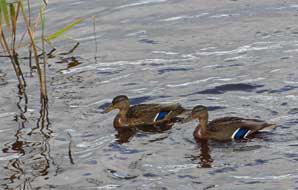 locations and
routes of access. She did add however that although some of the areas were
protected, hunters were free to shoot in other areas; there
was clearly a major conflict of interest between the conservationists and
bird-watchers and the hunting lobby.
locations and
routes of access. She did add however that although some of the areas were
protected, hunters were free to shoot in other areas; there
was clearly a major conflict of interest between the conservationists and
bird-watchers and the hunting lobby.
The other useful feature about Liminka Bay Visitor
Centre was that we could camp here: a corner of the parking area was set aside
with power supplies for camping. The charge was €19/night with access to
facilities in the centre's hostel together with dry toilet and log-stocked,
covered camp-fire by the camping area. We paid for our night's camp, and set off
along the 400m board-walk through extensive reed-beds
out to the Virkkula bird-watching tower. The tower overlooked a shore-side
meadow and the distant shallows of a protected inlet of Liminka Bay. From the
viewing platform we scanned the whole area through binoculars, but apart from a
pair of mallard splashing happily in a creek (see right), there was not another
bird to be seen.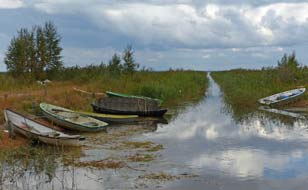
Along at Lumijoki village,
we turned off onto a side lane to find the Sannanlahti tower, which we hoped, from its position overlooking the main
body of Liminka Bay' open waters, would offer greater potential for bird-life.
Just beyond the village, the lane became rough gravel and narrowed to
single-track, leading eventually to a parking area by a narrow creek where hunters
moored their camouflaged boats (see left). We parked by a copse where the woodland floor
was covered with Dwarf Cornel laden with bright red ripe berries (see
right). A
track led from here across the reed-covered marshes towards the tower which
overlooked shore-side meadows and reed-beds and the distant waters of the Bay.
But apart from cows grazing in the flooded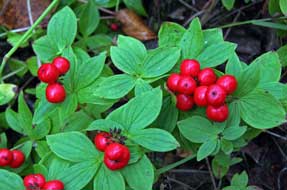 meadows and a flock of greenshanks
swirling around, there was little else to be seen. But walking back, we found
plants of Arctic Bramble with ripe and sweetly tasting fruit (see below left) (Photo
28 - Arctic Bramble ripe berries), the first time we had seen the
berries. meadows and a flock of greenshanks
swirling around, there was little else to be seen. But walking back, we found
plants of Arctic Bramble with ripe and sweetly tasting fruit (see below left) (Photo
28 - Arctic Bramble ripe berries), the first time we had seen the
berries.
The sky had been depressingly overcast all day and
with rain now beginning we hurried back to George. The dirt-lane wound around
through farm-land, eventually leading to a minor road out to Varjakka village
harbour at the far western tip of Liminka Bay. We returned in pouring rain to
Liminka Visitor Centre, and watched their film presentation of bird-life through
the seasons; in contrast with the wealth of bird-life for which the wetlands are
renowned, today in the dreary desolation of late August we had certainly
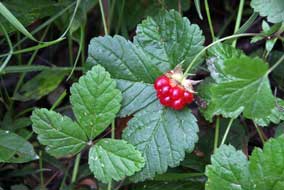 not
seen Liminka at its best! not
seen Liminka at its best!
The rain had eased and sun was now shining through
the birches with the golden light of late afternoon; we moved George over to the
camping area and set up camp. That evening we cooked one of the trip's better
suppers, Kylmänen elk meat (hirvikärsty) in creamy Lingonberry stew, and
after supper we lit a camp-fire under the covered hearth as the sun set over the
empty marshlands. From somewhere nearby, we could hear the gunshots of hunters
blasting away at who knows what around the shores of the bay. We sat in the
darkness as the fire finally died down to a ruddy glow.
A gloomy day to drive through the forests to
Puolanka: rain began again
during the night and this morning was driving against the side of the camper. It
was a dark, wet and thoroughly miserable day, and a wet walk carrying our
washing-up over to the Centre. But both the kitchen and showers were homely,
warm and well-equipped, a real luxury compared with many. For the helpful
standard of welcome, marsh-side setting, excellent facilities including wi-fi,
and good value price, Liminka Bay Visitor Centre Camping was a real find. But
the forecast gave a depressing outlook for the coming days. After shopping in
Liminka village, we resumed our journey, turning SE on Route 4 with the dark,
misty rain cloud making the flat farm land seem even more dreary than ever, and all
the ripening cereal crops battered down by 24 hours of heavy rain. A short
distance further and we turned off again onto Route 827 (click on Map 2 at top
right of page for our journey) to Tyrnävä, a busy service-centre village where
little children cycled home from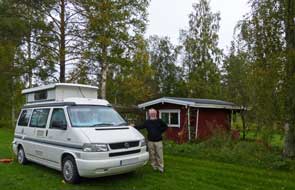 school in the pouring rain and mums pushed
buggies from the shops. Beyond Tyrnävä, the farming countryside gave way to
forest again making the surroundings more familiarly Finnish. The sky was so
dark with heavy, grey rain cloud that it almost seemed like dusk. A little
further and we crossed onto Route 834 heading NE through the forests towards
Ylikiiminki. Turning onto Route 836, we continued ahead on what was recalled
from 2012 as a delightful forest drive up the Kiiminkijoki valley on a sunny day; in contrast today, in pouring rain and low cloud on this lonely road, it was a
thoroughly wretched prospect. On and on through the dark, misty forests we
drove; how different from on a sunny day when light shining down through the
pines brings the forest alive with a richness of colour tones. Today everything
was a dull, flat grey monotone, with nothing to relieve the tedium of a drive in
such dreadful weather conditions. Only the ruddy-brown of bare pine trunks stood
out from the flat grey-green of misty forests. school in the pouring rain and mums pushed
buggies from the shops. Beyond Tyrnävä, the farming countryside gave way to
forest again making the surroundings more familiarly Finnish. The sky was so
dark with heavy, grey rain cloud that it almost seemed like dusk. A little
further and we crossed onto Route 834 heading NE through the forests towards
Ylikiiminki. Turning onto Route 836, we continued ahead on what was recalled
from 2012 as a delightful forest drive up the Kiiminkijoki valley on a sunny day; in contrast today, in pouring rain and low cloud on this lonely road, it was a
thoroughly wretched prospect. On and on through the dark, misty forests we
drove; how different from on a sunny day when light shining down through the
pines brings the forest alive with a richness of colour tones. Today everything
was a dull, flat grey monotone, with nothing to relieve the tedium of a drive in
such dreadful weather conditions. Only the ruddy-brown of bare pine trunks stood
out from the flat grey-green of misty forests.
A wet night at Puolankajärvi Camping:
reaching the junction with the busier Route 837, we turned NE heading towards
Puolanka, and along this stretch of forested road, we passed into the region of
Kainuu, and were slowed by a lone reindeer grazing the road-side, surely the last
of these gentle creatures that we should see this year. With the rain still
pouring, we turned off in the outskirts of Puolanka to find Puolankajärvi
Camping. We recalled from our 2012 stay at this traditional little campsite that
the soft, grassy ground was low-lying and sloped down towards the lake, tending
to become water-logged after rain. What should we find today, after 12 hours of
almost continuous heavy rain and forecast of even heavier overnight rain? it was a
concerning prospect. The lady-owner spoke limited English and was welcoming, the charge remained as in 2012 at €23, but as feared the sloping, low-lying ground
was indeed water-logged. The place was almost empty, and after careful
consideration,
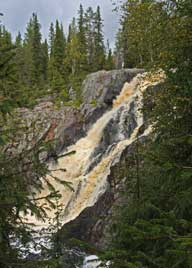 we selected a pitch just onto the grass alongside the huts and
backed onto chocks so that, even if the ground became totally sodden overnight, we
could run down onto the gravelly drive (see above right). With these precautions
we settled in, and pulled out the awning against the still pouring rain. With
heavy rain hammering on George's roof, we cooked a warming supper of elk
meat-balls in Lingonberry sauce, so welcome on such a cheerlessly wet evening.
As forecast, rain fell heavier than ever later in the evening and we battened
down snugly in George, thankful for his warmth and shelter. we selected a pitch just onto the grass alongside the huts and
backed onto chocks so that, even if the ground became totally sodden overnight, we
could run down onto the gravelly drive (see above right). With these precautions
we settled in, and pulled out the awning against the still pouring rain. With
heavy rain hammering on George's roof, we cooked a warming supper of elk
meat-balls in Lingonberry sauce, so welcome on such a cheerlessly wet evening.
As forecast, rain fell heavier than ever later in the evening and we battened
down snugly in George, thankful for his warmth and shelter.
Hepoköngäs waterfalls: at some point
during the night, the rain stopped, and this morning we looked out over a sodden
campsite with the sky still heavily overcast and rain dripping off the trees.
More importantly however, the ground quite remarkably had drained and although
still soft, the water-logged patches had cleared. Over breakfast we tried
telephoning our next campsite, Ristijärven Pirtti, to check their closing date,
but both numbers gave the 'number no longer in use' message. This was
worrying: had the site closed already or even worse closed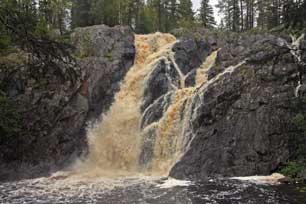 altogether? Facilities here
at Puolankajärvi were straightforward but perfectly functional with good hot
showers and a well-equipped kitchen/common room. In the village, we topped up
George with diesel and ourselves with provisions, and turned off onto Route 891
for the 2kms of approach lane leading to the Hepoköngäs parking area. altogether? Facilities here
at Puolankajärvi were straightforward but perfectly functional with good hot
showers and a well-equipped kitchen/common room. In the village, we topped up
George with diesel and ourselves with provisions, and turned off onto Route 891
for the 2kms of approach lane leading to the Hepoköngäs parking area.
The forest looked sodden and water-logged after
last night's rain, but at least today's weather seemed stable, lightly overcast with even a hint of sun. We kitted up and packed berry-picking pots in our
day-sacs, and set off along the broad 300m long approach path (Click here for map of Hepoköngäs Nature Trail). As we neared the
falls, the increasingly load roar of Hepoköngäs filled the forest air. One of
Finland's highest waterfalls,
Hepoköngäs drops
24m where the previously gentle-flowing Heinijoki river, one of the
Kiiminkijoki's headwater tributaries, drops in a spectacular cataract into a
granite basin. As we reached the top of the falls, it was clear that today,
after 24 hours of continuous heavy rain, the normally innocuous Heinijoki was
running in spate. We turned off onto the board-walk leading down to the foot of
the falls, crossing the now furiously fast-running torrent on a
wooden foot-bridge, with the peaty-brown water surging and foaming towards the
top lip of the falls. After
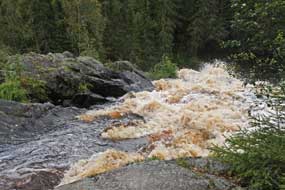 all the rain, the board-walk felt treacherously
slippery as we descended the escarpment slope alongside the falls, the air
filled with the roaring of cascading water. Partway down we could look through a
gap in the pines to the line of the falls (see above left), before dropping
down the lower slope to the foot of Hepoköngäs, looking directly across the
rocky basin with an unimpeded view of the full drop of the falls. Spray filled
the air, soaking trees and rocks and making the ground feel very insecure. With
the river in full spate, the falls were at their most spectacular, the
peaty-brown falling water foaming white, and the air filled with spray; despite
the gloomy light, these were perfect conditions to photograph the falls (Photo
29 - Hepoköngäs falls) all the rain, the board-walk felt treacherously
slippery as we descended the escarpment slope alongside the falls, the air
filled with the roaring of cascading water. Partway down we could look through a
gap in the pines to the line of the falls (see above left), before dropping
down the lower slope to the foot of Hepoköngäs, looking directly across the
rocky basin with an unimpeded view of the full drop of the falls. Spray filled
the air, soaking trees and rocks and making the ground feel very insecure. With
the river in full spate, the falls were at their most spectacular, the
peaty-brown falling water foaming white, and the air filled with spray; despite
the gloomy light, these were perfect conditions to photograph the falls (Photo
29 - Hepoköngäs falls)
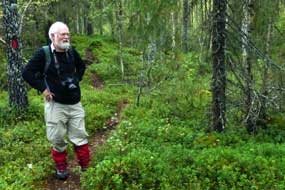 (see
above right). (see
above right).
Back up the slippery board-walk to the head of the
falls where the Heinijoki drops into the granite basin, 3 years ago on our first
visit the stream had glided with gentle innocence over the lip to drop the
cascade's 24m; today however the Heinijoki in full spate was a surging white-water torrent even before reaching the lip (see
left). Steep wooden steps led
down to the foot of the falls of this side of the basin, and the start of the 3
kms nature trail circuit. With the river running in such high spate,
there were doubts if the path in the narrow canyon immediately alongside the
still fast-running river would be passable. The ground was already water-logged
and trees dripping as we progressed along the narrow path, but sun broke
through lighting the rain falling in the dark river canyon, a truly magical
moment. Reaching the junction where
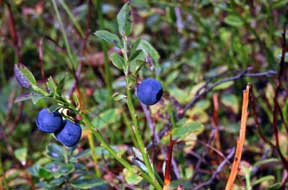 the long distance path continued ahead, we
left the river to climb steeply up into the forest (see right). Here a
abundance of juicy ripe Bilberries covered the slope and we began today's
berry-picking among the soaking wet bushes, making slow progress as we stopped
every few steps to pick more Bilberries
(Photo
30 - Bilberry-picking). They were now at their peak of ripeness (see
left) and we were able to scoop handfuls of berries from the stems, soon
filling our pots
(Photo 31 - Ripe Bilberries).
The
on-going path crossed areas of marshy ground on board-walks, and higher ground
with more ripe Bilberries, and brought us back to the parking area. Stowing our soaking boots, we returned along the approach lane to continue our journey
eastwards. the long distance path continued ahead, we
left the river to climb steeply up into the forest (see right). Here a
abundance of juicy ripe Bilberries covered the slope and we began today's
berry-picking among the soaking wet bushes, making slow progress as we stopped
every few steps to pick more Bilberries
(Photo
30 - Bilberry-picking). They were now at their peak of ripeness (see
left) and we were able to scoop handfuls of berries from the stems, soon
filling our pots
(Photo 31 - Ripe Bilberries).
The
on-going path crossed areas of marshy ground on board-walks, and higher ground
with more ripe Bilberries, and brought us back to the parking area. Stowing our soaking boots, we returned along the approach lane to continue our journey
eastwards.
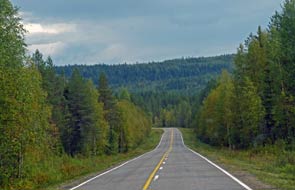 Through the forests of Kainuu to Ristijärvi: Route 891 undulated through the
forested terrain, the distant views presenting an uninterrupted vista of the
vast expanse of Kainuu's endless forests; nothing but trees stretching away to
distant horizons with the birches now showing clear hints of Ruska autumnal gold
(see right). We drove on through this wonderful empty forested landscape,
eventually crossing the Suomusalmi railway line to reach the junction with Route 5 at Hyrynslami whose municipality covers an area of over 1,500 square kms with a
population density of just 1.73 inhabitants per square km. Turning south here onto
Route 5, we followed the highway down the Emäkoji valley, very conscious of the
frequent elk warning sings and keeping a wary eye open for these great beast
lumbering across the road; a collision at speed with one of these would result
in total write-off. We finally reached Ristijärvi, a peaceful little village
with war cemetery in its churchyard, and pulled into the S-Market for provisions
top-up. Through the forests of Kainuu to Ristijärvi: Route 891 undulated through the
forested terrain, the distant views presenting an uninterrupted vista of the
vast expanse of Kainuu's endless forests; nothing but trees stretching away to
distant horizons with the birches now showing clear hints of Ruska autumnal gold
(see right). We drove on through this wonderful empty forested landscape,
eventually crossing the Suomusalmi railway line to reach the junction with Route 5 at Hyrynslami whose municipality covers an area of over 1,500 square kms with a
population density of just 1.73 inhabitants per square km. Turning south here onto
Route 5, we followed the highway down the Emäkoji valley, very conscious of the
frequent elk warning sings and keeping a wary eye open for these great beast
lumbering across the road; a collision at speed with one of these would result
in total write-off. We finally reached Ristijärvi, a peaceful little village
with war cemetery in its churchyard, and pulled into the S-Market for provisions
top-up.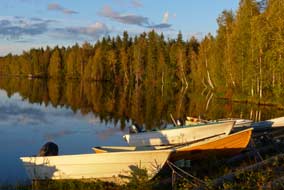
Ristijärven Pirtti Camping: just south of the village, we reached
Ristijärven Pirtti Camping, and thankfully the reception was open: a new family
had taken over the campsite this year and telephone numbers had changed which
explained why we had been unable to contact them. We were greeted with the same
welcoming hospitality as in 2012, and settled into a pitch in the woodland area
at the far corner, spreading out all our wet boots and kit to dry in the now bright sunshine. Having so far this year seen few Lingonberries, the floor
of the woodland grove where we were now camped was covered with bright red
Lingonberries almost ripe enough for picking. It really was a beautiful spot for
tomorrow's day in camp, and we sat with the slider open enjoying the woodland
setting and view over the lake.
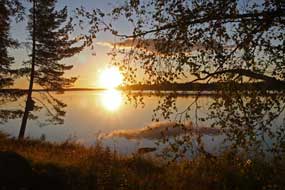 We woke the following morning to a clear sky and bright sun and, with the midges
and blackfly now virtually gone at last, were able to sit out for breakfast
in our forest grove in warm sunshine, a delightful spot for morning log-writing
(Photo
32- Log-writing on a sunny morning). Facilities at Ristijärven Pirtti
were high standard with a well-equipped kitchen/wash-up and clean, modern
WC/showers. All the static caravans
progressively emptied this morning leaving us to enjoy the sunshine in glorious
peace. Later in the morning, we walked over to the short nature trail just
beyond the campsite into the lake-shore forest. The lad who had booked us in
yesterday seemed to have no idea of this lovely feature, and in fact the nature
trail was much neglected with sagging board-walk; the new owners had made
significant improvements around the campsite and perhaps not yet got round
to repairing the board-walk. We enjoyed a productive but highly relaxing day in this lovely lake-side setting (see above
left), and that
evening the sun set across the lake (see right) to give a perfect
end to this long to be remembered day at Ristijärven Pirtti Camping (Photo
33 - Sunset across the lake). We woke the following morning to a clear sky and bright sun and, with the midges
and blackfly now virtually gone at last, were able to sit out for breakfast
in our forest grove in warm sunshine, a delightful spot for morning log-writing
(Photo
32- Log-writing on a sunny morning). Facilities at Ristijärven Pirtti
were high standard with a well-equipped kitchen/wash-up and clean, modern
WC/showers. All the static caravans
progressively emptied this morning leaving us to enjoy the sunshine in glorious
peace. Later in the morning, we walked over to the short nature trail just
beyond the campsite into the lake-shore forest. The lad who had booked us in
yesterday seemed to have no idea of this lovely feature, and in fact the nature
trail was much neglected with sagging board-walk; the new owners had made
significant improvements around the campsite and perhaps not yet got round
to repairing the board-walk. We enjoyed a productive but highly relaxing day in this lovely lake-side setting (see above
left), and that
evening the sun set across the lake (see right) to give a perfect
end to this long to be remembered day at Ristijärven Pirtti Camping (Photo
33 - Sunset across the lake).
 A drive through the forests to Sotkamo:
it was a chill autumnal night, and this morning the sun was just breaking
through the morning mist lighting the dew-covered cob-webs hanging between
forest bushes; it was a beautiful start to a new week. Just north of Ristijärvi
village, we turned off onto Route 888 (click on Map 3 at top right of page for
our journey) heading south-eastward into the forest-lands of Kainuu. With
morning sun lighting the trees, this was a delightful road. Unless you have
experienced it, the lonely beauty of such forested landscape is hard to imagine:
the dark shapely silhouettes of tall conifers and the contrasting lighter greens
of birches just beginning to gain their tinge of autumnal gold, and as the road
breasts the top of a rise, the vast expanse of this endless sea of trees
stretches away to the misty horizon (see left). We crossed Route 89 which runs
eastwards to a border-crossing into Russia, and which we had crossed on our
northward journey from Kuhmo. For the next 40 kms, the road continued south
through these lonely forests passing just the occasional farmstead, finally
dropping down into the more agricultural valley of the Kuusianjoki river on the
approach to the small town of Sotkamo. The town's municipality covers an area of
almost 3,000 square kms of which 10% is water and the rest largely made up of empty Kainuu forest. A drive through the forests to Sotkamo:
it was a chill autumnal night, and this morning the sun was just breaking
through the morning mist lighting the dew-covered cob-webs hanging between
forest bushes; it was a beautiful start to a new week. Just north of Ristijärvi
village, we turned off onto Route 888 (click on Map 3 at top right of page for
our journey) heading south-eastward into the forest-lands of Kainuu. With
morning sun lighting the trees, this was a delightful road. Unless you have
experienced it, the lonely beauty of such forested landscape is hard to imagine:
the dark shapely silhouettes of tall conifers and the contrasting lighter greens
of birches just beginning to gain their tinge of autumnal gold, and as the road
breasts the top of a rise, the vast expanse of this endless sea of trees
stretches away to the misty horizon (see left). We crossed Route 89 which runs
eastwards to a border-crossing into Russia, and which we had crossed on our
northward journey from Kuhmo. For the next 40 kms, the road continued south
through these lonely forests passing just the occasional farmstead, finally
dropping down into the more agricultural valley of the Kuusianjoki river on the
approach to the small town of Sotkamo. The town's municipality covers an area of
almost 3,000 square kms of which 10% is water and the rest largely made up of empty Kainuu forest.
Vuokatinranta Camping: we reached Sotkamo church on the town
outskirts and turned into the main street. Sotkamo is set on a sandy wedge of
isthmus, the remains of a glacial esker, sandwiched between lakeland on all
sides. After shopping at the S-Market, we continued westwards on Route 76 which
runs along a further narrow esker-ridge forming a causeway between Pirttijärvi on the northern side and Iso-Sapso-järvi on the southern side,
with the
settlement of Hirvenniemi spread along the broader part of the esker.
Through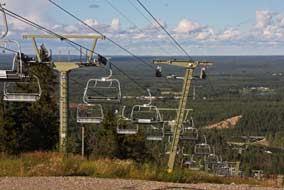 the scattered ski-resort of Vuokatti, we turned off following signs for tonight's planned campsite, Vuokatinranta; we knew little about the place other
than it seemed to be part of a Lutheran holiday-centre. It had the appearance of
a conference-centre, with a small camping area overlooking Nuasjärvi. As we
looked around, the warden came out to greet us and confirmed we could camp; with its lovely lake-side
setting and very acceptable price of €19/night (including SCC discount), we
readily accepted and booked in. The the scattered ski-resort of Vuokatti, we turned off following signs for tonight's planned campsite, Vuokatinranta; we knew little about the place other
than it seemed to be part of a Lutheran holiday-centre. It had the appearance of
a conference-centre, with a small camping area overlooking Nuasjärvi. As we
looked around, the warden came out to greet us and confirmed we could camp; with its lovely lake-side
setting and very acceptable price of €19/night (including SCC discount), we
readily accepted and booked in. The
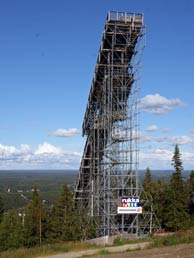 warden introduced himself as Anssi
Hukkanen, and provided us with a local map and highlighted key features,
including the skiing hill of Vuokatinvaara which we could drive up to reach the
summit ski station. He told us more about Sotkamo with its lake-beach on the
sandy esker, and its successful Finnish baseball team, Sotkamon Jymy, which had
won this year's Finnish championship finals. He also described features at nearby
Kajaani where he was a town guide. Our conversation turned to Finnish politics, ranging from Urho Kekkonen's presidency and his controversial policy steering a middle
course between USSR and the West so preserving Finland's independence, through to
the current political situation with Juha
Sipilä's fragile coalition government; we described our visit to the Eduskunta
and witnessing the election of the new Speaker (realising she was the same age
as our younger daughter!). Anssi also told us more about Vuokatinranta's role as
a Lutheran holiday centre, hosting teenagers' confirmation camps and Christian
gatherings. warden introduced himself as Anssi
Hukkanen, and provided us with a local map and highlighted key features,
including the skiing hill of Vuokatinvaara which we could drive up to reach the
summit ski station. He told us more about Sotkamo with its lake-beach on the
sandy esker, and its successful Finnish baseball team, Sotkamon Jymy, which had
won this year's Finnish championship finals. He also described features at nearby
Kajaani where he was a town guide. Our conversation turned to Finnish politics, ranging from Urho Kekkonen's presidency and his controversial policy steering a middle
course between USSR and the West so preserving Finland's independence, through to
the current political situation with Juha
Sipilä's fragile coalition government; we described our visit to the Eduskunta
and witnessing the election of the new Speaker (realising she was the same age
as our younger daughter!). Anssi also told us more about Vuokatinranta's role as
a Lutheran holiday centre, hosting teenagers' confirmation camps and Christian
gatherings.
Vuokatinvaara Skiing hill: before settling in at the camping area, we drove
back to the main Route 76 and turned up the lane leading onto Vuokatinvaara
hill. The lane wound around at a steady 7% gradient, ending at a parking area
close to the summit. This side of the hill was dominated by a gigantic ski-jump
tower, a
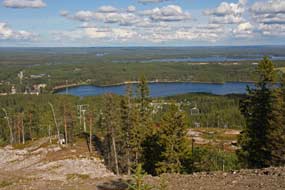 flimsy-looking structure of dizzying proportions and terrifying height;
we later learnt that this was an Olympic standard ski-jump training tower (see
above left). Up at the highest point of the hill-top of Iso-Pölly amid all the
paraphernalia of ski-lifts, a look-out point gave panoramic vistas down the
ski-slopes to the lake-spattered valley below (see above right). Climbing
further to the top winding stations, we stood on their platforms looking down
the lines of the chair-lifts to the valley below (Photo
34 - Vuokatinvaara chair-lifts) (see above right). Today everything was deserted and the
hill-side green and scarred with the bare lines of ski-runs; it was impossible
for us to imagine what this same setting would be like when snow-covered in
winter. Another look-out point gave distant views across to Iso-Sapso-järvi and
distant Sotkamo township
wedged on the shores of the lake (see right). Back down at Vuokatinranta Camping, we settled in
at the camping area, with the warm sun shining across the inlet of Nuasjärvi; it
was a truly delightful and peaceful setting (Photo
35 - Vuokatinranta Camping). flimsy-looking structure of dizzying proportions and terrifying height;
we later learnt that this was an Olympic standard ski-jump training tower (see
above left). Up at the highest point of the hill-top of Iso-Pölly amid all the
paraphernalia of ski-lifts, a look-out point gave panoramic vistas down the
ski-slopes to the lake-spattered valley below (see above right). Climbing
further to the top winding stations, we stood on their platforms looking down
the lines of the chair-lifts to the valley below (Photo
34 - Vuokatinvaara chair-lifts) (see above right). Today everything was deserted and the
hill-side green and scarred with the bare lines of ski-runs; it was impossible
for us to imagine what this same setting would be like when snow-covered in
winter. Another look-out point gave distant views across to Iso-Sapso-järvi and
distant Sotkamo township
wedged on the shores of the lake (see right). Back down at Vuokatinranta Camping, we settled in
at the camping area, with the warm sun shining across the inlet of Nuasjärvi; it
was a truly delightful and peaceful setting (Photo
35 - Vuokatinranta Camping).
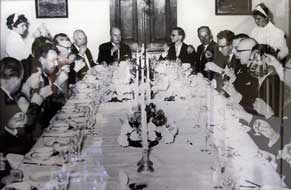 A
day in Kajaani: before
heading into Kajaani, we called in at reception to confirm our plan to return
later. We asked Anssi about the wooden church at Paltaniemi with its famous
wall-paintings, and in his role as Kajaani town-guide, he offered to show us the
paintings after he had finished work at Vuokatinranta later today. As we drove
along Route 76, the sun broke through lighting the beautiful forested terrain.
Reaching Kajaani, we managed to find street parking near to the university, right
outside the Sirius Restaurant where Anssi had recommended we try to see the
photos of Finnish President Kekkonen hosting a banquet for the Soviet leader
Brezhnev. A
day in Kajaani: before
heading into Kajaani, we called in at reception to confirm our plan to return
later. We asked Anssi about the wooden church at Paltaniemi with its famous
wall-paintings, and in his role as Kajaani town-guide, he offered to show us the
paintings after he had finished work at Vuokatinranta later today. As we drove
along Route 76, the sun broke through lighting the beautiful forested terrain.
Reaching Kajaani, we managed to find street parking near to the university, right
outside the Sirius Restaurant where Anssi had recommended we try to see the
photos of Finnish President Kekkonen hosting a banquet for the Soviet leader
Brezhnev.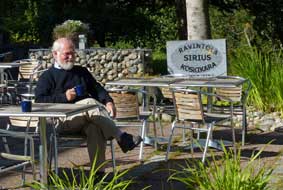 The post-war building had originally housed the wealthy owner of a
local paper mill, and later had been used as venue for the meeting between
Kekkonen and Brezhnev. We went in for coffee and were shown the photos in the
dining room (see left). Outside on the terrace, we sat with our coffee looking
down towards the river and remains of Kajaani castle (Photo
36 - Kajaani Castle). Just along from the restaurant we found the
memorial statue of the seated figure of Elias Lönnrot who had been District
Doctor at Kajaani for 20 years and had completed writing the Finnish epic,
Kalevala here in 1835 (Photo
37 - Elias Lönnrot statue) (Click
here to learn about Kalevala). Up into the main shopping street
of Kauppakatu, to the little square by the Engel-designed Old Town Hall (Raatihuone
in Finnish), things were changed from our 2012 visit. At that time, it had been
a lively meeting place for the town's elderly folk with an accordioniste to
entertain them with familiar songs and a stall selling Muikku, delicious
crispy fried whitebait from local lakes.
The post-war building had originally housed the wealthy owner of a
local paper mill, and later had been used as venue for the meeting between
Kekkonen and Brezhnev. We went in for coffee and were shown the photos in the
dining room (see left). Outside on the terrace, we sat with our coffee looking
down towards the river and remains of Kajaani castle (Photo
36 - Kajaani Castle). Just along from the restaurant we found the
memorial statue of the seated figure of Elias Lönnrot who had been District
Doctor at Kajaani for 20 years and had completed writing the Finnish epic,
Kalevala here in 1835 (Photo
37 - Elias Lönnrot statue) (Click
here to learn about Kalevala). Up into the main shopping street
of Kauppakatu, to the little square by the Engel-designed Old Town Hall (Raatihuone
in Finnish), things were changed from our 2012 visit. At that time, it had been
a lively meeting place for the town's elderly folk with an accordioniste to
entertain them with familiar songs and a stall selling Muikku, delicious
crispy fried whitebait from local lakes.
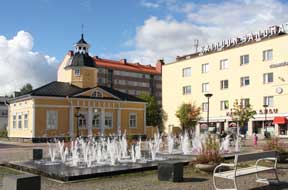 3 years on, the square had a 'tidied
up', sanitised air: gone were the old folk, Muikku stall and street
entertainment, replaced
with fountains. We took our photos of the
ochre-coloured, wooden Raatihuone and the neighbouring Kainuun Sanomat
newspaper offices (see left) (Photo
38 - Kajaani Old Town Hall), and walked along Kauppakatu to Kajaani's
Kauppatori (Market Square) to browse the stalls. One was manned by a jovial Thai
selling fried Muikku; here was lunch! We had enjoyed eating these
delicious crispy-fried lake fish during our 2012 visit to Finland, and had
been looking forward to buying them again from street stalls. We sat for our
lunch of Muikku at the Thai's stall, while he let us into the secret of
good Muikku; they should be fried in butter and not oil. And good they
were! (Photo
39 - Muikku for lunch). It had been sunny
until now, but dark clouds were gathering, soon filling the sky and emptying
their contents on the 3 years on, the square had a 'tidied
up', sanitised air: gone were the old folk, Muikku stall and street
entertainment, replaced
with fountains. We took our photos of the
ochre-coloured, wooden Raatihuone and the neighbouring Kainuun Sanomat
newspaper offices (see left) (Photo
38 - Kajaani Old Town Hall), and walked along Kauppakatu to Kajaani's
Kauppatori (Market Square) to browse the stalls. One was manned by a jovial Thai
selling fried Muikku; here was lunch! We had enjoyed eating these
delicious crispy-fried lake fish during our 2012 visit to Finland, and had
been looking forward to buying them again from street stalls. We sat for our
lunch of Muikku at the Thai's stall, while he let us into the secret of
good Muikku; they should be fried in butter and not oil. And good they
were! (Photo
39 - Muikku for lunch). It had been sunny
until now, but dark clouds were gathering, soon filling the sky and emptying
their contents on the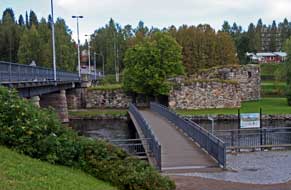 centre of Kajaani. The Thai packed his cooking equipment
and departed in his van, insisting we should shelter from the pouring rain under
his stall. When the rain eventually eased and brighter cloud drifted over, we
looked around the fruit stalls, asking when the Puolukka would be ripe (Photo
40 - Kajaani market stalls): still not for another 2 weeks after the
poor summer. centre of Kajaani. The Thai packed his cooking equipment
and departed in his van, insisting we should shelter from the pouring rain under
his stall. When the rain eventually eased and brighter cloud drifted over, we
looked around the fruit stalls, asking when the Puolukka would be ripe (Photo
40 - Kajaani market stalls): still not for another 2 weeks after the
poor summer.
With the rain finally stopped, we walked back,
with just time to re-visit the scant remains of Kajaani's Swedish Castle. Built
in 1604 by Per Brahe, Governor General when Finland was a province of the
Swedish Empire, to protect the wild unsettled frontier region of remote Kainuu from Russian attack, the castle served as a prison for 20 years
for the
dissident Catholic historian Johannes
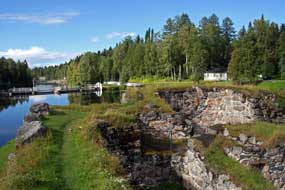 Messenius
whose portrait we had seen in Oulu Cathedral. The castle was totally destroyed
in a Russian attack during the Great Northern War in 1716, and what little
remains now serves as support for the modern town bridge (see right). Across the
bridge, we could look down onto more extensive remains of the castle against the
back-drop of the river, dammed at this point for an HEP generating station, and
the Tar Canal (Photo
41 - Remains of Kajaani Castle) (Terve Kanava in Finnish) (see
left). The canal had been cut in 1846 through the bed rock to bypass the
neighbouring rapids for passage of narrow-boats laden with barrels of pine-tar
from the Kainuu forests down into Oulujärvi lake and on to Oulu for shipment as
caulking for wooden sailing ships.
Along the side-lane down to the canal locks, stands a memorial to the 2,000
young volunteers Messenius
whose portrait we had seen in Oulu Cathedral. The castle was totally destroyed
in a Russian attack during the Great Northern War in 1716, and what little
remains now serves as support for the modern town bridge (see right). Across the
bridge, we could look down onto more extensive remains of the castle against the
back-drop of the river, dammed at this point for an HEP generating station, and
the Tar Canal (Photo
41 - Remains of Kajaani Castle) (Terve Kanava in Finnish) (see
left). The canal had been cut in 1846 through the bed rock to bypass the
neighbouring rapids for passage of narrow-boats laden with barrels of pine-tar
from the Kainuu forests down into Oulujärvi lake and on to Oulu for shipment as
caulking for wooden sailing ships.
Along the side-lane down to the canal locks, stands a memorial to the 2,000
young volunteers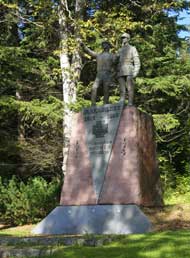 who went off to Imperial Germany in 1915~17 for military training, fired with
zeal for Finland's independence from Tsarist Russia (see right). The Kaiser was
more than happy to ferment rebellion among the Tsar's western dominions, just as
he was in giving Lenin trans-shipment in a sealed train to encourage the
Bolshevik revolution in 1917. Following this when Finland secured her
independence, these militarily trained elite leaders, named as the Jäger Movement,
formed the backbone of the right-wing White Guards in the 1918 Finnish Civil
War.
who went off to Imperial Germany in 1915~17 for military training, fired with
zeal for Finland's independence from Tsarist Russia (see right). The Kaiser was
more than happy to ferment rebellion among the Tsar's western dominions, just as
he was in giving Lenin trans-shipment in a sealed train to encourage the
Bolshevik revolution in 1917. Following this when Finland secured her
independence, these militarily trained elite leaders, named as the Jäger Movement,
formed the backbone of the right-wing White Guards in the 1918 Finnish Civil
War.
The lane alongside the river-basin led down to the
Tar Canal locks (Photo
42 - Kajaani Tar Canal) which were constructed to navigate
the otherwise impassable rocky gorge of the neighbouring Ämmäkoski rapids, the
natural river connection between lakes Nuasjärvi and Oulujärvi. The canal remained in
use for tar-boats until
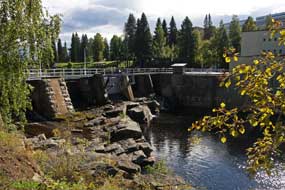 1915, and the locks were restored in the 1970s. A
replica narrow-boat loaded with tar-barrels passes through the lock on summer
Sundays. The lock was a staggering 50 feet in depth and of minimum width to
accommodate the narrow tar-boats. We crossed the lock bridge to photograph the
rocky Ämmäkoski gorge (Photo
43 - Ämmäkoski gorge), now dry with the rapids blocked by the hydro-electric power plant dam (see left). This did show vividly
the loss of height over which the natural rapids, now blocked by the dam, would
once have cascaded forming an obstacle for tar-boats which the Tar Canal had
bypassed. 1915, and the locks were restored in the 1970s. A
replica narrow-boat loaded with tar-barrels passes through the lock on summer
Sundays. The lock was a staggering 50 feet in depth and of minimum width to
accommodate the narrow tar-boats. We crossed the lock bridge to photograph the
rocky Ämmäkoski gorge (Photo
43 - Ämmäkoski gorge), now dry with the rapids blocked by the hydro-electric power plant dam (see left). This did show vividly
the loss of height over which the natural rapids, now blocked by the dam, would
once have cascaded forming an obstacle for tar-boats which the Tar Canal had
bypassed.
George's 2 hour parking allowance had now expired
and we hurried back across the bridge before he got a ticket. On the far side of town, we re-parked at the railway station to see Kajaani's architectural pièce
de résistance, the restored 1904 Art Nouveau wooden railway station (Rautatieasema
in Finnish) (Photo
44 - Kajaani's Art Nouveau railway station). Across the town, amid an
area of anonymous modern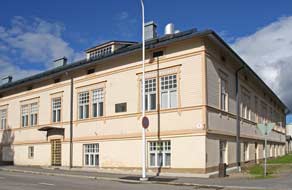 apartment blocks, Kalliokatu 7, a distinctive early 20th century wooden town
house, was the former home from 1911~1926 of local-boy-made-good Urho Kekkonen,
Finland's long-standing president from 1956~81 (see right). A relief plaque with
Kekkonen's portrait and familiar bald head and heavy spectacles (see below left), recalled his
residency here during his formative years in Kajaani where he worked as a
journalist before moving onward and upward to Helsinki.
apartment blocks, Kalliokatu 7, a distinctive early 20th century wooden town
house, was the former home from 1911~1926 of local-boy-made-good Urho Kekkonen,
Finland's long-standing president from 1956~81 (see right). A relief plaque with
Kekkonen's portrait and familiar bald head and heavy spectacles (see below left), recalled his
residency here during his formative years in Kajaani where he worked as a
journalist before moving onward and upward to Helsinki.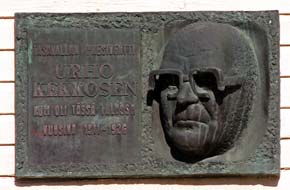
Along Kirkkokatu, the modern Orthodox Church,
built to serve Karelian refugees re-settled in Kajaani after WW2, was all locked
up. But in a nearby park stood the incongruous intestinal curvature of the
modern memorial to Kekkonen (1900~86) (see below right); what possible bearing this grotesque
piece of metal could have on the Finnish President (unless of course intended as
unsubtle irony at his expense!) defied understanding. Across to the neo-Gothic
wooden Lutheran Church, we walked along the lines of fuschia-decorated graves in
the war cemetery to pay our respects to the Finnish war dead (Photo
45 - Kajaani Lutheran Church). But time was running out; it was
approaching 4-00pm and we had to drive out to Paltaniemi to meet with Anssi for
our visit to the painted church.
Paltaniemi painted church:
we arrived out at Paltaniemi to photograph the wooden church's exterior (Photo
46 - Paltaniemi Church). The second church at Paltaniemi was destroyed
by the Russians in the same year as Kajaani 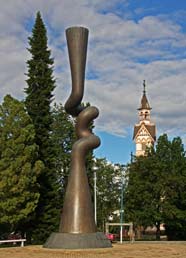 Castle,
and the present church was completed in 1726. Emanual Granberg, a church artist
from Western Finland, was commissioned to paint the murals of Biblical scenes
which now decorate the church's interior walls. Paltaniemi must have been an
area of wealthy tar-merchants and farmers to
have afforded such expensive and elaborate paintings for their church. Anssi
joined us and opened up the Castle,
and the present church was completed in 1726. Emanual Granberg, a church artist
from Western Finland, was commissioned to paint the murals of Biblical scenes
which now decorate the church's interior walls. Paltaniemi must have been an
area of wealthy tar-merchants and farmers to
have afforded such expensive and elaborate paintings for their church. Anssi
joined us and opened up the
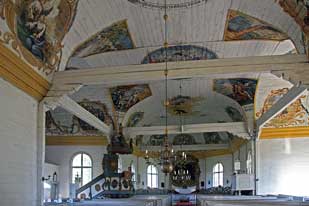 church with the huge key, to reveal the
continuous frieze of painted panels high on the walls of both the chancel,
transept and nave (see left). The panels showed scenes from the Old and
New Testaments, beginning with Adam and Eve in the Garden of Eden, the Expulsion
from the Garden, Abraham, Cain and Abel, the Burning Bush, the Annunciation (Photo
47 - Annunciation), Nativity, Gethsemane, Trial before the High
Priest and Pilot, Crucifixion, Resurrection, concluding over the altar with a
symbolic representation of washing away the sins of the world. But the most
breathtaking painting, covering the entire west end wall, showed a Last
Judgement depiction in gruesome detail with crowned evil queen riding a
multi-headed dragon and leading the souls of the damned (all women as it
happened!) into Hell. The lower sections had been considered so shocking that
they had been painted over (see below left). church with the huge key, to reveal the
continuous frieze of painted panels high on the walls of both the chancel,
transept and nave (see left). The panels showed scenes from the Old and
New Testaments, beginning with Adam and Eve in the Garden of Eden, the Expulsion
from the Garden, Abraham, Cain and Abel, the Burning Bush, the Annunciation (Photo
47 - Annunciation), Nativity, Gethsemane, Trial before the High
Priest and Pilot, Crucifixion, Resurrection, concluding over the altar with a
symbolic representation of washing away the sins of the world. But the most
breathtaking painting, covering the entire west end wall, showed a Last
Judgement depiction in gruesome detail with crowned evil queen riding a
multi-headed dragon and leading the souls of the damned (all women as it
happened!) into Hell. The lower sections had been considered so shocking that
they had been painted over (see below left).
Outside in the church-yard, Anssi pointed out a
memorial stone showing pleading hands reaching out to ears of corn and the dates
1866~68; this commemorated the mid-19th century years of mass starvation in
Finland from failed harvests. He also took us around to the nearby wooden shack,
said to be the stable in which Tsar Alexander I had breakfasted on his tour of
inspection of Kajaani in 1819, just 10 years after Finland's incorporation into
the Tsarist Empire as the Grand Duchy. This opportunity to see the wall
paintings at Paltaniemi Church had been a real privilege, and we express our
sincere thanks to Anssi for sparing us his time to make this possible.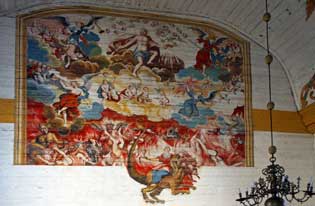
A final night's camp at Vuokatinranta:
we set off for the drive around the northern shore of lake Nuasjärvi back to
camp at Vuokatinranta. The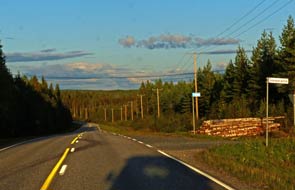 route mainly followed winding minor lanes, with the golden light of the setting
sun making the forests glow and casting George's long shadow on the road ahead
(see right). But evening dusk was a nervous time to be driving trough forests
with increased risk of elks, and we kept a careful eye open for them running
into the road. We reached Vuokatti by 7-45pm and paused at the K-Market for
provisions. The lad at the check-out addressed us in perfect English without any
prompting. How did you know we were English? we asked; because your Finnish
accent was so bad, he replied with a twinkle! We had tried so hard with our
Finnish, but shared the laughter!
route mainly followed winding minor lanes, with the golden light of the setting
sun making the forests glow and casting George's long shadow on the road ahead
(see right). But evening dusk was a nervous time to be driving trough forests
with increased risk of elks, and we kept a careful eye open for them running
into the road. We reached Vuokatti by 7-45pm and paused at the K-Market for
provisions. The lad at the check-out addressed us in perfect English without any
prompting. How did you know we were English? we asked; because your Finnish
accent was so bad, he replied with a twinkle! We had tried so hard with our
Finnish, but shared the laughter!
Back around at the campsite, we settled in as the
evening sun declined across the lake across the lake, casting a golden trail
over the water; it was a glorious sight and worthy climax to a memorable stay
here at Vuokatinranta (Photo
48 - Vuokatinranta sunset).
Our final 2 weeks in Finland take us south through the
towns and cities of Central and Southern Finland: IIsalmi, Kuopio, Jyväskylä,
the wooden church of Petäjävesi, Helvetinjärvi National Park, the second city
Tampere, Sammallahdenmäki Bronze Age burial grounds, and Rauma, finishing up at the
port-city of Turku where we began our Finnish venture 5 months ago. From there
it will be the ferry back to Sweden, across Southern Sweden and the Øresund
Bridge to Denmark. Join us again in a couple of weeks for the final part of our
travels around Finland.
Final edition
to be published quite soon
|
Sheila and Paul |
Published: 16 February 2016 |
|
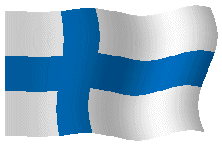
 CAMPING
IN FINLAND 2015: Rovaniemi, Napapiiri Hiking Area, Kemijärvi, Auttiköngäs, Ranua,
Pudasjärvi, Oulu, Liminka Bay, Puolanka, Hepoköngäs, Ristijärvi, Sotkamo, Vuokatti, and
Kajaani:
CAMPING
IN FINLAND 2015: Rovaniemi, Napapiiri Hiking Area, Kemijärvi, Auttiköngäs, Ranua,
Pudasjärvi, Oulu, Liminka Bay, Puolanka, Hepoköngäs, Ristijärvi, Sotkamo, Vuokatti, and
Kajaani: South from Kittilä to Rovaniemi: Route 79 south from Kittilä
followed the valley of the now wide and gently-flowing Ounasjoki through pine
and spruce forest, delightful countryside on a bright, sunny morning. Despite
being a main road traffic was light, but the greater hazard was reindeer
wandering across the carriageway (
South from Kittilä to Rovaniemi: Route 79 south from Kittilä
followed the valley of the now wide and gently-flowing Ounasjoki through pine
and spruce forest, delightful countryside on a bright, sunny morning. Despite
being a main road traffic was light, but the greater hazard was reindeer
wandering across the carriageway ( A visit to Santa Claus
at Rovaniemi: 6
kms further, we pulled into the commercial park of the Santa Claus Village (Joulupukin
Pajkylä), indicated by an archway across the road to symbolise its setting on
the notional line of the Arctic Circe; the actual line has long since drifted
away northwards perhaps
repelled by the hoards of
A visit to Santa Claus
at Rovaniemi: 6
kms further, we pulled into the commercial park of the Santa Claus Village (Joulupukin
Pajkylä), indicated by an archway across the road to symbolise its setting on
the notional line of the Arctic Circe; the actual line has long since drifted
away northwards perhaps
repelled by the hoards of tourists who flock here by the plane- and bus-load to
spend their money. We had 2 reasons for stopping off at this unlikely place: the
first was to take advantage of the novel and modestly un-commercialised service
offered by the Finnish Postal Service at Santa's Main Post Office (see left),
and secondly to pay a return visit to the Great Man himself at his Lapland HQ.
Across the car park, at Santa's Main Post Office (Joulupukin Pääposti),
one of the smilingly charming elves assured
us
that we could still buy our card, write it at the writing tables provided, buy a
stamp at the counter, and post it in the specially provided posting-box for
delivery at Christmas duly franked with Santa's Arctic Circle postmark (see
right); all this for the price of an ordinary stamp.
tourists who flock here by the plane- and bus-load to
spend their money. We had 2 reasons for stopping off at this unlikely place: the
first was to take advantage of the novel and modestly un-commercialised service
offered by the Finnish Postal Service at Santa's Main Post Office (see left),
and secondly to pay a return visit to the Great Man himself at his Lapland HQ.
Across the car park, at Santa's Main Post Office (Joulupukin Pääposti),
one of the smilingly charming elves assured
us
that we could still buy our card, write it at the writing tables provided, buy a
stamp at the counter, and post it in the specially provided posting-box for
delivery at Christmas duly franked with Santa's Arctic Circle postmark (see
right); all this for the price of an ordinary stamp.
 We chose our card, wrote
our message as if from Santa to our granddaughters (in Grandpa's disguised
hand-writing!), and posted it in the Christmas box. And sure enough in
mid-December, it was duly delivered to our granddaughters in Devon; now how
could even sceptically disbelieving 10 and 8 year olds fail to be convinced of
Santa's existence when they unexpectedly receive a personal greeting from the Great
Man
himself!
We chose our card, wrote
our message as if from Santa to our granddaughters (in Grandpa's disguised
hand-writing!), and posted it in the Christmas box. And sure enough in
mid-December, it was duly delivered to our granddaughters in Devon; now how
could even sceptically disbelieving 10 and 8 year olds fail to be convinced of
Santa's existence when they unexpectedly receive a personal greeting from the Great
Man
himself!  linguistic requirements of His job, (He spoke with us in charmingly accented English), and about our
wish for our visit to bring credibility to His existence in the eyes of our
growing granddaughters. Our audience with the Great Man was all very civilised
and unrushed. We said our farewells with a shake of His hand, and the elf
expressed no surprise that we tactfully declined to part with €25 for an official
photo of our audience! Our re-visit to Santa's HQ had been a happy one: despite
all the accompanying tackiness of Santa Claus Village, the Main Event with a
chance to sit and chat with the Great Man himself, and to post our card for
Christmas delivery from His Main Post-Office, was all low-key and without
charge, with no pressure whatsoever to buy the over-priced photos. You could
take or leave the souvenir shops crammed with racks of tasteless ephemera, and
simply enjoy the magic of a remarkably un-commercialised
visit to Father Christmas. And of course, we did just that!
linguistic requirements of His job, (He spoke with us in charmingly accented English), and about our
wish for our visit to bring credibility to His existence in the eyes of our
growing granddaughters. Our audience with the Great Man was all very civilised
and unrushed. We said our farewells with a shake of His hand, and the elf
expressed no surprise that we tactfully declined to part with €25 for an official
photo of our audience! Our re-visit to Santa's HQ had been a happy one: despite
all the accompanying tackiness of Santa Claus Village, the Main Event with a
chance to sit and chat with the Great Man himself, and to post our card for
Christmas delivery from His Main Post-Office, was all low-key and without
charge, with no pressure whatsoever to buy the over-priced photos. You could
take or leave the souvenir shops crammed with racks of tasteless ephemera, and
simply enjoy the magic of a remarkably un-commercialised
visit to Father Christmas. And of course, we did just that! some good walking opportunities, and since
both the Rovaniemi
campsites were ludicrously over-priced, we hoped to find a quiet spot for a
wild-camp. We pulled into the Vikaköngäs parking area alongside the Vikaköngäs
rapids, with its white-water slalom canoe course marked out under the footbridge
(see above right). A board-walk led alongside the rapids to a cluster of
laavu-huts and camp-fire hearth with log-store. This river-side spot overlooking
the Vikaköngäs rapids seemed a perfect wild-camp spot, tucked well away from the
road with the roar of the river-rapids to drown
some good walking opportunities, and since
both the Rovaniemi
campsites were ludicrously over-priced, we hoped to find a quiet spot for a
wild-camp. We pulled into the Vikaköngäs parking area alongside the Vikaköngäs
rapids, with its white-water slalom canoe course marked out under the footbridge
(see above right). A board-walk led alongside the rapids to a cluster of
laavu-huts and camp-fire hearth with log-store. This river-side spot overlooking
the Vikaköngäs rapids seemed a perfect wild-camp spot, tucked well away from the
road with the roar of the river-rapids to drown out any traffic noise, and we
could light a camp-fire for a grilled sausage supper. The Arctic Circle Hiking
Area is centred on the rapids of the Raudanjoki river, a tributary of the
Kemijoki. The hilly and marshy terrain has both managed forests and areas of
wilderness forest and several nature trails. Between 19~20th centuries, the
river had been used for log-floating, and when this ended in 1980s, the
log-storage basin area at Vikaköngäs was converted for recreational usage; it
was here that we now camped
(
out any traffic noise, and we
could light a camp-fire for a grilled sausage supper. The Arctic Circle Hiking
Area is centred on the rapids of the Raudanjoki river, a tributary of the
Kemijoki. The hilly and marshy terrain has both managed forests and areas of
wilderness forest and several nature trails. Between 19~20th centuries, the
river had been used for log-floating, and when this ended in 1980s, the
log-storage basin area at Vikaköngäs was converted for recreational usage; it
was here that we now camped
( all the
way down here to arrive and camp during the night; they were on their way to
Sweden to fly for a week's holiday in Malta! Their English was limited, and our
Russian almost non-existent, but we managed to converse about their adventurous
trip.
all the
way down here to arrive and camp during the night; they were on their way to
Sweden to fly for a week's holiday in Malta! Their English was limited, and our
Russian almost non-existent, but we managed to converse about their adventurous
trip.  The foot-bridge
leading over to the island gave a spectacular view along the length of the rapids
with the peaty waters and surging currents sparkling in the bright sunlight (see
right)
(
The foot-bridge
leading over to the island gave a spectacular view along the length of the rapids
with the peaty waters and surging currents sparkling in the bright sunlight (see
right)
( (
(
 Route
82 to Kemijärvi and fungal-infected sickly spruce trees: from
Makialampi parking area, we set off for the 60 km drive on Route 82 to Kemijärvi.
The road initially ran north-easterly, again crossing the line of the Arctic
Circle, through delightfully rolling, densely forested terrain. But over the last
couple of days, we had noticed that all of the spruces were now consistently
showing a yellowing of their needles, which when brushed shed a pollen-like
dust. This turned out to be a fungal infection called Spruce Needle Rust. The
fungus lives for half its life cycle on spruce needles and the rest of the year
on ground plants of the heather family including Lingonberry and Labrador-tea.
These release fungal spores which, particularly in cool,
wet summers as this year, infect the young growing-tips of spruce needles, and
the fungus develops
Route
82 to Kemijärvi and fungal-infected sickly spruce trees: from
Makialampi parking area, we set off for the 60 km drive on Route 82 to Kemijärvi.
The road initially ran north-easterly, again crossing the line of the Arctic
Circle, through delightfully rolling, densely forested terrain. But over the last
couple of days, we had noticed that all of the spruces were now consistently
showing a yellowing of their needles, which when brushed shed a pollen-like
dust. This turned out to be a fungal infection called Spruce Needle Rust. The
fungus lives for half its life cycle on spruce needles and the rest of the year
on ground plants of the heather family including Lingonberry and Labrador-tea.
These release fungal spores which, particularly in cool,
wet summers as this year, infect the young growing-tips of spruce needles, and
the fungus develops over the summer months. The spruce needles at the
growing-tips turn yellow as tube-like projections form on the infected needles,
releasing powdery spores which re-infect the heather-plant ground-cover,
continuing the fungus' life-cycle. Severely infected spruce trees develop a tan
colour, and the infected needles die and fall off. The impact of this fungal
infection on spruces is said to be purely cosmetic, but since it affects the
young growing needles, it must be damaging, causing defoliation, disfigurement
and reduced growth. We had seen the yellowing effect of the fungal infection on
wholesale masses of spruce trees, both large and small, so its impact was
wide-spread on entire forests. On the drive down to Kemijärvi over pine and
spruce forested hills (see left and right), we saw much evidence of Spruce
Needle Rust. We had not noticed it on such a scale in previous summers, so
perhaps this year's cooler weather had made the fungal infestation far more
prevalent.
over the summer months. The spruce needles at the
growing-tips turn yellow as tube-like projections form on the infected needles,
releasing powdery spores which re-infect the heather-plant ground-cover,
continuing the fungus' life-cycle. Severely infected spruce trees develop a tan
colour, and the infected needles die and fall off. The impact of this fungal
infection on spruces is said to be purely cosmetic, but since it affects the
young growing needles, it must be damaging, causing defoliation, disfigurement
and reduced growth. We had seen the yellowing effect of the fungal infection on
wholesale masses of spruce trees, both large and small, so its impact was
wide-spread on entire forests. On the drive down to Kemijärvi over pine and
spruce forested hills (see left and right), we saw much evidence of Spruce
Needle Rust. We had not noticed it on such a scale in previous summers, so
perhaps this year's cooler weather had made the fungal infestation far more
prevalent.  Kemijärvi Camping:
reaching the
outskirts of Kemijärvi, we turned into Kemijärvi Camping on the lake shore (see
left). This had been an expensive site in 2012,
but today prices had risen even more to €30/night, giving the place the
dishonour of being the most expensive campsite in Finland; although a pleasantly turfed site with hedged pitches, we shall not be returning! When we stayed in
July 3 years ago, we had experienced our first Midnight Sun; tonight in late
August the sun
declined much further round to the west and set at 10-0pm with a ruddy glow. The
following morning we took a leisurely pace with our morning jobs; the sun was
just
Kemijärvi Camping:
reaching the
outskirts of Kemijärvi, we turned into Kemijärvi Camping on the lake shore (see
left). This had been an expensive site in 2012,
but today prices had risen even more to €30/night, giving the place the
dishonour of being the most expensive campsite in Finland; although a pleasantly turfed site with hedged pitches, we shall not be returning! When we stayed in
July 3 years ago, we had experienced our first Midnight Sun; tonight in late
August the sun
declined much further round to the west and set at 10-0pm with a ruddy glow. The
following morning we took a leisurely pace with our morning jobs; the sun was
just beginning to break through, and fieldfares pecked around the dewy grass
(
beginning to break through, and fieldfares pecked around the dewy grass
( A
welcoming return to Matkatupa Camping: leaving Kemijärvi, we set off
to drive the 26 kms south through the forests to Matkatupa Camping. The
forest floor was littered with boulders, as if the retreating glaciers that had
gouged out the hollows later filled by Kemijärvi lake had deposited an extra
load for its efforts around here. 20 kms further, at N66.562504 - E27.252789, we
reached the line of Napapiiri, the Arctic Circle for our southward
crossing after 6 weeks this year within the Arctic region; here we paused for
photographs
A
welcoming return to Matkatupa Camping: leaving Kemijärvi, we set off
to drive the 26 kms south through the forests to Matkatupa Camping. The
forest floor was littered with boulders, as if the retreating glaciers that had
gouged out the hollows later filled by Kemijärvi lake had deposited an extra
load for its efforts around here. 20 kms further, at N66.562504 - E27.252789, we
reached the line of Napapiiri, the Arctic Circle for our southward
crossing after 6 weeks this year within the Arctic region; here we paused for
photographs
 (
( The
following morning, a heavy mist hung over the lake with the autumnal smell of
mouldering leaves filling the damp air (see left). Sheila put on a load of
laundry in the campsite washing machine, while Paul chatted with Urho by the
log-splitting machine and helped load logs into the winter fuel store.
The
following morning, a heavy mist hung over the lake with the autumnal smell of
mouldering leaves filling the damp air (see left). Sheila put on a load of
laundry in the campsite washing machine, while Paul chatted with Urho by the
log-splitting machine and helped load logs into the winter fuel store. Amid swarming blackfly we strung a washing line between trees down by the lake
but with the sky still overcast and sun struggling to break through, the washing
was unlikely to dry. The sun set across the lake (see right), and by 9-45pm it
was almost dark.
Amid swarming blackfly we strung a washing line between trees down by the lake
but with the sky still overcast and sun struggling to break through, the washing
was unlikely to dry. The sun set across the lake (see right), and by 9-45pm it
was almost dark. impassable
16m high waterfalls and rapids at Auttiköngäs, a log-flume had been constructed
alongside the cascade for logs to be floated down into the ongoing lower gorge,
with a dam and sluice gates at the top to build up a head of water for the
flume.
impassable
16m high waterfalls and rapids at Auttiköngäs, a log-flume had been constructed
alongside the cascade for logs to be floated down into the ongoing lower gorge,
with a dam and sluice gates at the top to build up a head of water for the
flume. From the footbridge over the dam, the morning
sunshine lit the whole length of the log-flume alongside the cascading Auttiköngäs
falls, the sheer rocky side-walls of the enclosing gorge, and surrounding
forested fells (
From the footbridge over the dam, the morning
sunshine lit the whole length of the log-flume alongside the cascading Auttiköngäs
falls, the sheer rocky side-walls of the enclosing gorge, and surrounding
forested fells ( steps up the steep, forested hill-side. Here the forest floor was covered with a
lush carpet of Bilberry laden with fruit ripe for picking as we climbed the
slope. Further steps mounted the hill-side's next rocky tier, and the on-going
path now passed several huge erratic boulders, finally reaching the rocky slabbed summit plateau of Könkäänvaara hill with its observation tower (see
right). From the
tower's observation platform, we could look out over the distant forested
landscape with the yellow rust-infested spruces standing out clearly amid the
sea of dark green pines
(
steps up the steep, forested hill-side. Here the forest floor was covered with a
lush carpet of Bilberry laden with fruit ripe for picking as we climbed the
slope. Further steps mounted the hill-side's next rocky tier, and the on-going
path now passed several huge erratic boulders, finally reaching the rocky slabbed summit plateau of Könkäänvaara hill with its observation tower (see
right). From the
tower's observation platform, we could look out over the distant forested
landscape with the yellow rust-infested spruces standing out clearly amid the
sea of dark green pines
( and the plants laden with ripe berries. Despite the swarming blackfly, we filled
our berry-picking pots as we descended the forested slope to the parking area.
On the descent, we passed a series of young spruces, like baby Christmas trees,
totally infected and discoloured by rust fungus; it was a tragic sight.
and the plants laden with ripe berries. Despite the swarming blackfly, we filled
our berry-picking pots as we descended the forested slope to the parking area.
On the descent, we passed a series of young spruces, like baby Christmas trees,
totally infected and discoloured by rust fungus; it was a tragic sight.  the
S-Market for provisions. It was only a short distance out of the village to our
planned campsite Ranuajärvi Camping, a pleasant site used in 2012, under pines on
the shore of its eponymous lake. As we passed Ranuajärvi, we noticed more of the
yellow fungus spore scum floating in the shallows (see left). We turned off to
the campsite, looking forward to settling in after a long day - but disaster!
The gate was locked, and site closed, whether permanently was unclear, but a
sign said it had closed early in August. There was no option but to use the site
at Ranua Zoo, a new but unimpressive place just
the
S-Market for provisions. It was only a short distance out of the village to our
planned campsite Ranuajärvi Camping, a pleasant site used in 2012, under pines on
the shore of its eponymous lake. As we passed Ranuajärvi, we noticed more of the
yellow fungus spore scum floating in the shallows (see left). We turned off to
the campsite, looking forward to settling in after a long day - but disaster!
The gate was locked, and site closed, whether permanently was unclear, but a
sign said it had closed early in August. There was no option but to use the site
at Ranua Zoo, a new but unimpressive place just north of the village. It was crammed full with holiday-making caravans and
camping-cars, with all their screaming dogs, yapping kids and materialistic
paraphernalia. Regretting thoroughly the necessity to use such an alien
campsite, we found a corner spot. Determined to make the most of it, we
discovered that their clothes drying-machine was free of charge and used it to finish
drying our bag-loads of semi wet laundry. The peace of a dusky evening was
further disturbed by delinquents from the camping-cars parading their juvenile
inadequacy by hurtling around the campsite yelling, as their even more
inadequate parents made even more noise. What a ghastly place!
north of the village. It was crammed full with holiday-making caravans and
camping-cars, with all their screaming dogs, yapping kids and materialistic
paraphernalia. Regretting thoroughly the necessity to use such an alien
campsite, we found a corner spot. Determined to make the most of it, we
discovered that their clothes drying-machine was free of charge and used it to finish
drying our bag-loads of semi wet laundry. The peace of a dusky evening was
further disturbed by delinquents from the camping-cars parading their juvenile
inadequacy by hurtling around the campsite yelling, as their even more
inadequate parents made even more noise. What a ghastly place!  Kelankylä we paused as a final
symbolic herd of reindeer ambled past
(
Kelankylä we paused as a final
symbolic herd of reindeer ambled past
( Jyrkkäkoski
Camping at Pudasjärvi: a warm welcome and delightful camping area
among pine woodland had left us with fond memories of our stay at
Jyrkkäkoski Camping in 2012. How things can change in just 3 years! Today we
were greeted in an off-hand manner by the new owner: the charge had increased
inevitably, but the woodland camping area was now the preserve of Thai workers
employed for commercial berry-picking. The now available camping area was in
open woodland with little shade and some 400m from the facilities building, but
we pitched under the trees trying to gauge the least sun heated spot. The
alleged wi-fi signal failed to reach the camping area, and on returning to
reception, we discovered the run-down state of the facilities: 3 years on they
were now grubby, smelly and truly disgusting, some of the worst of the trip, and
it was clear that the Thai workers' recompense for overnight berry-picking at
whatever dubious rates they were paid was
Jyrkkäkoski
Camping at Pudasjärvi: a warm welcome and delightful camping area
among pine woodland had left us with fond memories of our stay at
Jyrkkäkoski Camping in 2012. How things can change in just 3 years! Today we
were greeted in an off-hand manner by the new owner: the charge had increased
inevitably, but the woodland camping area was now the preserve of Thai workers
employed for commercial berry-picking. The now available camping area was in
open woodland with little shade and some 400m from the facilities building, but
we pitched under the trees trying to gauge the least sun heated spot. The
alleged wi-fi signal failed to reach the camping area, and on returning to
reception, we discovered the run-down state of the facilities: 3 years on they
were now grubby, smelly and truly disgusting, some of the worst of the trip, and
it was clear that the Thai workers' recompense for overnight berry-picking at
whatever dubious rates they were paid was
 to
base their fast-food stall cooking in the campsite kitchen! But despite the
disappointment of Jyrkkäkoski Camping 2015, we settled in, and for one of the
few times this summer, sat outside to enjoy the early evening sunshine and
comparative absence now of midges (see right). After supper that evening, we lit
a log fire at the camp-fire hearth and sat around this as the sky grew dusky. As
if to add to the offence already caused, the ill-mannered owner came over urging
us not to use too much wood; the log-store was full to overflowing and we
responded by stoking the fire further!
to
base their fast-food stall cooking in the campsite kitchen! But despite the
disappointment of Jyrkkäkoski Camping 2015, we settled in, and for one of the
few times this summer, sat outside to enjoy the early evening sunshine and
comparative absence now of midges (see right). After supper that evening, we lit
a log fire at the camp-fire hearth and sat around this as the sky grew dusky. As
if to add to the offence already caused, the ill-mannered owner came over urging
us not to use too much wood; the log-store was full to overflowing and we
responded by stoking the fire further! a
huge orange harvest moon rose above the southern horizon. We had enjoyed a
pleasantly relaxing and sunny day in camp under the pines, but the happy
recollections from our 2012 stay at Jyrkkäkoski Camping had been regrettably
soured by its now disgusting facilities and ill-mannered new owner .
a
huge orange harvest moon rose above the southern horizon. We had enjoyed a
pleasantly relaxing and sunny day in camp under the pines, but the happy
recollections from our 2012 stay at Jyrkkäkoski Camping had been regrettably
soured by its now disgusting facilities and ill-mannered new owner . Out to the Bothnian Gulf at Oulu: today we should move westwards
out to the Bothnian Gulf coast at Oulu; a change to rain was forecast for later
in the week, but we hoped that the present sunny weather would last for our day
in what is our favourite city of Northern Finland. But first we drove back into Pudasjärvi
to re-stock with provisions, re-fill
the camper with diesel, and to visit the Pudasjärvi branch of Kylmänen whose
factory-shop we had used at Sodankylä (see right). The shop was well stocked and
we bought packs of elk meat, elk meat-balls and reindeer sausages.
Out to the Bothnian Gulf at Oulu: today we should move westwards
out to the Bothnian Gulf coast at Oulu; a change to rain was forecast for later
in the week, but we hoped that the present sunny weather would last for our day
in what is our favourite city of Northern Finland. But first we drove back into Pudasjärvi
to re-stock with provisions, re-fill
the camper with diesel, and to visit the Pudasjärvi branch of Kylmänen whose
factory-shop we had used at Sodankylä (see right). The shop was well stocked and
we bought packs of elk meat, elk meat-balls and reindeer sausages. From Pudasjärvi, we turned off westwards
onto Route 855, a peaceful back-road route along the Iijoki valley out to the
Bothnian Gulf coast. We paused at an untranslatable war memorial, probably
recalling the Finns' pursuit of the retreating Germans from Lapland in 1944.
With the sun bright,
this was a delightful road winding through pine and birch woodlands (see left),
with spruce seeming less infected with rust fungus than further north. As we
moved westwards, the continuous forest gave way to increasingly cleared
farmland, and at Tannila we turned SW onto Route 849 through more intensive
farmland to reach the charmingly named village of Yli-Ii, meaning Upper Ii.
Alongside the now wide Iijoki, we drove along the lower valley to cross the
river into Ii village, leading to the junction with the main Route 4/E75 highway.
Suddenly after all the quiet back-lanes of Lapland, we were in busy traffic as
we turned south along the highway, to the small town of Haukipudas, now
virtually a suburb of Oulu, to re-visit the famous Baroque painted parish
church.
From Pudasjärvi, we turned off westwards
onto Route 855, a peaceful back-road route along the Iijoki valley out to the
Bothnian Gulf coast. We paused at an untranslatable war memorial, probably
recalling the Finns' pursuit of the retreating Germans from Lapland in 1944.
With the sun bright,
this was a delightful road winding through pine and birch woodlands (see left),
with spruce seeming less infected with rust fungus than further north. As we
moved westwards, the continuous forest gave way to increasingly cleared
farmland, and at Tannila we turned SW onto Route 849 through more intensive
farmland to reach the charmingly named village of Yli-Ii, meaning Upper Ii.
Alongside the now wide Iijoki, we drove along the lower valley to cross the
river into Ii village, leading to the junction with the main Route 4/E75 highway.
Suddenly after all the quiet back-lanes of Lapland, we were in busy traffic as
we turned south along the highway, to the small town of Haukipudas, now
virtually a suburb of Oulu, to re-visit the famous Baroque painted parish
church.
 graves of local Winter and Continuation War dead were decorated with
fuschia shrubs (
graves of local Winter and Continuation War dead were decorated with
fuschia shrubs ( evening grew dark and dewy even earlier, and a
magnificently clear half-moon rose (see right).
evening grew dark and dewy even earlier, and a
magnificently clear half-moon rose (see right). the 10-35am #15 bus; this arrived promptly and, although fares were expensive at €3-30 per passenger journey with no senior's reductions, the
drivers were ultra helpful and polite and the service efficient. We
followed the journey into the city on our city-plan, recalling sights as the bus
approached the centre past the cathedral to stop in Torikatu right outside the
TIC. Paul was hoping to find a solution today for his hors de combat
camera; a helpful member of the TIC staff provided the name and location of a
camera shop which he felt certain would be able to help. We headed through
central Oulu's grid of streets, and found the Oulun Kuva
Camera Shop along Hallituskatu (see left). The lady spoke faultless English, immediately diagnosed the problem
as a faulty lens, and supplied a suitable replacement. Although expensive, Paul was back
in photographic business after a agonizing 10 day gap; we were fortunate to have
found such a good photographic shop, now almost unknown in UK.
the 10-35am #15 bus; this arrived promptly and, although fares were expensive at €3-30 per passenger journey with no senior's reductions, the
drivers were ultra helpful and polite and the service efficient. We
followed the journey into the city on our city-plan, recalling sights as the bus
approached the centre past the cathedral to stop in Torikatu right outside the
TIC. Paul was hoping to find a solution today for his hors de combat
camera; a helpful member of the TIC staff provided the name and location of a
camera shop which he felt certain would be able to help. We headed through
central Oulu's grid of streets, and found the Oulun Kuva
Camera Shop along Hallituskatu (see left). The lady spoke faultless English, immediately diagnosed the problem
as a faulty lens, and supplied a suitable replacement. Although expensive, Paul was back
in photographic business after a agonizing 10 day gap; we were fortunate to have
found such a good photographic shop, now almost unknown in UK. Paul's revitalised camera was put to immediate
use, as we returned along Kirkkokatu to photograph Oulu's grandiose neo-Gothic
City Hall
(see above right) (
Paul's revitalised camera was put to immediate
use, as we returned along Kirkkokatu to photograph Oulu's grandiose neo-Gothic
City Hall
(see above right) ( sculpted figures of Sanna
Koivisto's memorial, Ajan Kulku (Course of Time), created in 2005 to
commemorate the 400th anniversary of Oulu's foundation. The wall-top procession
of 32 figures represent characters who had influenced the city's development
over its 400 years history, starting with its founder King Karl IX of Sweden;
the wall-top line of figures include a man rolling a tar barrel, fishermen
holding salmon, a fireman from the 1822 great fire, a mother with children, a
student reading her newspaper, a yuppie clutching his mobile phone, and at the
very front symbolising the future a small boy sits at the end of the wall (
sculpted figures of Sanna
Koivisto's memorial, Ajan Kulku (Course of Time), created in 2005 to
commemorate the 400th anniversary of Oulu's foundation. The wall-top procession
of 32 figures represent characters who had influenced the city's development
over its 400 years history, starting with its founder King Karl IX of Sweden;
the wall-top line of figures include a man rolling a tar barrel, fishermen
holding salmon, a fireman from the 1822 great fire, a mother with children, a
student reading her newspaper, a yuppie clutching his mobile phone, and at the
very front symbolising the future a small boy sits at the end of the wall ( It was time now to head down to the Kauppatori
(Market Square) for lunch, on the way passing the 1901 elegant red-brick
Kauppahalli (Market Hall) (
It was time now to head down to the Kauppatori
(Market Square) for lunch, on the way passing the 1901 elegant red-brick
Kauppahalli (Market Hall) ( area. After
lunch we walked around the stalls hoping to buy Lingonberries (Pulolukka
in Finnish), but after such a miserable summer, these were not expected to be
ripe for another couple of weeks (
area. After
lunch we walked around the stalls hoping to buy Lingonberries (Pulolukka
in Finnish), but after such a miserable summer, these were not expected to be
ripe for another couple of weeks ( their
way upstream against the current. Today however this was closed and we could
only view the water rushing along the open channel above ground (
their
way upstream against the current. Today however this was closed and we could
only view the water rushing along the open channel above ground ( Dodging the processions of speeding cyclists, we
continued across the dam where on our 2012 visit, the sluice-gates had been open
creating a spectacular cascade when viewed from above on the dam pathway and
from a distance across the
parkland. Today there was just the view along the
semi-dry lower area below the dam and the distant artificial fountains over
towards the generating plant (see right) (
Dodging the processions of speeding cyclists, we
continued across the dam where on our 2012 visit, the sluice-gates had been open
creating a spectacular cascade when viewed from above on the dam pathway and
from a distance across the
parkland. Today there was just the view along the
semi-dry lower area below the dam and the distant artificial fountains over
towards the generating plant (see right) (
 Liminka
Bay wetlands: the forecast rain
arrived during the night and this morning was heavily overcast (see left).
Despite Nallikari's pretentions and its unduly expensive prices, the facilities
were care-worn and lacked the standard to be expected of a 4-star site; we were
not sorry to be leaving. After shopping at a K-Market in the suburb of
Välivainio, we re-joined the E75 urban motorway. City traffic was fast and
furious but we made progress through Oulu's southern outskirts; the terrain
could have been anywhere in Europe. 20 kms south, we turned off onto Route 813
(click on Map 2 at top right of page) at Liminka heading towards Lumijoki for
our day around the
Liminka
Bay wetlands: the forecast rain
arrived during the night and this morning was heavily overcast (see left).
Despite Nallikari's pretentions and its unduly expensive prices, the facilities
were care-worn and lacked the standard to be expected of a 4-star site; we were
not sorry to be leaving. After shopping at a K-Market in the suburb of
Välivainio, we re-joined the E75 urban motorway. City traffic was fast and
furious but we made progress through Oulu's southern outskirts; the terrain
could have been anywhere in Europe. 20 kms south, we turned off onto Route 813
(click on Map 2 at top right of page) at Liminka heading towards Lumijoki for
our day around the  locations and
routes of access. She did add however that although some of the areas were
protected, hunters were free to shoot in other areas; there
was clearly a major conflict of interest between the conservationists and
bird-watchers and the hunting lobby.
locations and
routes of access. She did add however that although some of the areas were
protected, hunters were free to shoot in other areas; there
was clearly a major conflict of interest between the conservationists and
bird-watchers and the hunting lobby.
 meadows and a flock of greenshanks
swirling around, there was little else to be seen. But walking back, we found
plants of Arctic Bramble with ripe and sweetly tasting fruit (see below left) (
meadows and a flock of greenshanks
swirling around, there was little else to be seen. But walking back, we found
plants of Arctic Bramble with ripe and sweetly tasting fruit (see below left) ( not
seen Liminka at its best!
not
seen Liminka at its best! school in the pouring rain and mums pushed
buggies from the shops. Beyond Tyrnävä, the farming countryside gave way to
forest again making the surroundings more familiarly Finnish. The sky was so
dark with heavy, grey rain cloud that it almost seemed like dusk. A little
further and we crossed onto Route 834 heading NE through the forests towards
Ylikiiminki. Turning onto Route 836, we continued ahead on what was recalled
from 2012 as a delightful forest drive up the Kiiminkijoki valley on a sunny day; in contrast today, in pouring rain and low cloud on this lonely road, it was a
thoroughly wretched prospect. On and on through the dark, misty forests we
drove; how different from on a sunny day when light shining down through the
pines brings the forest alive with a richness of colour tones. Today everything
was a dull, flat grey monotone, with nothing to relieve the tedium of a drive in
such dreadful weather conditions. Only the ruddy-brown of bare pine trunks stood
out from the flat grey-green of misty forests.
school in the pouring rain and mums pushed
buggies from the shops. Beyond Tyrnävä, the farming countryside gave way to
forest again making the surroundings more familiarly Finnish. The sky was so
dark with heavy, grey rain cloud that it almost seemed like dusk. A little
further and we crossed onto Route 834 heading NE through the forests towards
Ylikiiminki. Turning onto Route 836, we continued ahead on what was recalled
from 2012 as a delightful forest drive up the Kiiminkijoki valley on a sunny day; in contrast today, in pouring rain and low cloud on this lonely road, it was a
thoroughly wretched prospect. On and on through the dark, misty forests we
drove; how different from on a sunny day when light shining down through the
pines brings the forest alive with a richness of colour tones. Today everything
was a dull, flat grey monotone, with nothing to relieve the tedium of a drive in
such dreadful weather conditions. Only the ruddy-brown of bare pine trunks stood
out from the flat grey-green of misty forests. we selected a pitch just onto the grass alongside the huts and
backed onto chocks so that, even if the ground became totally sodden overnight, we
could run down onto the gravelly drive (see above right). With these precautions
we settled in, and pulled out the awning against the still pouring rain. With
heavy rain hammering on George's roof, we cooked a warming supper of elk
meat-balls in Lingonberry sauce, so welcome on such a cheerlessly wet evening.
As forecast, rain fell heavier than ever later in the evening and we battened
down snugly in George, thankful for his warmth and shelter.
we selected a pitch just onto the grass alongside the huts and
backed onto chocks so that, even if the ground became totally sodden overnight, we
could run down onto the gravelly drive (see above right). With these precautions
we settled in, and pulled out the awning against the still pouring rain. With
heavy rain hammering on George's roof, we cooked a warming supper of elk
meat-balls in Lingonberry sauce, so welcome on such a cheerlessly wet evening.
As forecast, rain fell heavier than ever later in the evening and we battened
down snugly in George, thankful for his warmth and shelter. altogether? Facilities here
at Puolankajärvi were straightforward but perfectly functional with good hot
showers and a well-equipped kitchen/common room. In the village, we topped up
George with diesel and ourselves with provisions, and turned off onto Route 891
for the 2kms of approach lane leading to the Hepoköngäs parking area.
altogether? Facilities here
at Puolankajärvi were straightforward but perfectly functional with good hot
showers and a well-equipped kitchen/common room. In the village, we topped up
George with diesel and ourselves with provisions, and turned off onto Route 891
for the 2kms of approach lane leading to the Hepoköngäs parking area. all the rain, the board-walk felt treacherously
slippery as we descended the escarpment slope alongside the falls, the air
filled with the roaring of cascading water. Partway down we could look through a
gap in the pines to the line of the falls (see above left), before dropping
down the lower slope to the foot of Hepoköngäs, looking directly across the
rocky basin with an unimpeded view of the full drop of the falls. Spray filled
the air, soaking trees and rocks and making the ground feel very insecure. With
the river in full spate, the falls were at their most spectacular, the
peaty-brown falling water foaming white, and the air filled with spray; despite
the gloomy light, these were perfect conditions to photograph the falls (
all the rain, the board-walk felt treacherously
slippery as we descended the escarpment slope alongside the falls, the air
filled with the roaring of cascading water. Partway down we could look through a
gap in the pines to the line of the falls (see above left), before dropping
down the lower slope to the foot of Hepoköngäs, looking directly across the
rocky basin with an unimpeded view of the full drop of the falls. Spray filled
the air, soaking trees and rocks and making the ground feel very insecure. With
the river in full spate, the falls were at their most spectacular, the
peaty-brown falling water foaming white, and the air filled with spray; despite
the gloomy light, these were perfect conditions to photograph the falls ( (see
above right).
(see
above right). the long distance path continued ahead, we
left the river to climb steeply up into the forest (see right). Here a
abundance of juicy ripe Bilberries covered the slope and we began today's
berry-picking among the soaking wet bushes, making slow progress as we stopped
every few steps to pick more Bilberries
(
the long distance path continued ahead, we
left the river to climb steeply up into the forest (see right). Here a
abundance of juicy ripe Bilberries covered the slope and we began today's
berry-picking among the soaking wet bushes, making slow progress as we stopped
every few steps to pick more Bilberries
( Through the forests of Kainuu to Ristijärvi: Route 891 undulated through the
forested terrain, the distant views presenting an uninterrupted vista of the
vast expanse of Kainuu's endless forests; nothing but trees stretching away to
distant horizons with the birches now showing clear hints of Ruska autumnal gold
(see right). We drove on through this wonderful empty forested landscape,
eventually crossing the Suomusalmi railway line to reach the junction with Route 5 at Hyrynslami whose municipality covers an area of over 1,500 square kms with a
population density of just 1.73 inhabitants per square km. Turning south here onto
Route 5, we followed the highway down the Emäkoji valley, very conscious of the
frequent elk warning sings and keeping a wary eye open for these great beast
lumbering across the road; a collision at speed with one of these would result
in total write-off. We finally reached Ristijärvi, a peaceful little village
with war cemetery in its churchyard, and pulled into the S-Market for provisions
top-up.
Through the forests of Kainuu to Ristijärvi: Route 891 undulated through the
forested terrain, the distant views presenting an uninterrupted vista of the
vast expanse of Kainuu's endless forests; nothing but trees stretching away to
distant horizons with the birches now showing clear hints of Ruska autumnal gold
(see right). We drove on through this wonderful empty forested landscape,
eventually crossing the Suomusalmi railway line to reach the junction with Route 5 at Hyrynslami whose municipality covers an area of over 1,500 square kms with a
population density of just 1.73 inhabitants per square km. Turning south here onto
Route 5, we followed the highway down the Emäkoji valley, very conscious of the
frequent elk warning sings and keeping a wary eye open for these great beast
lumbering across the road; a collision at speed with one of these would result
in total write-off. We finally reached Ristijärvi, a peaceful little village
with war cemetery in its churchyard, and pulled into the S-Market for provisions
top-up.
 We woke the following morning to a clear sky and bright sun and, with the midges
and blackfly now virtually gone at last, were able to sit out for breakfast
in our forest grove in warm sunshine, a delightful spot for morning log-writing
(
We woke the following morning to a clear sky and bright sun and, with the midges
and blackfly now virtually gone at last, were able to sit out for breakfast
in our forest grove in warm sunshine, a delightful spot for morning log-writing
( the scattered ski-resort of Vuokatti, we turned off following signs for tonight's planned campsite, Vuokatinranta; we knew little about the place other
than it seemed to be part of a Lutheran holiday-centre. It had the appearance of
a conference-centre, with a small camping area overlooking Nuasjärvi. As we
looked around, the warden came out to greet us and confirmed we could camp; with its lovely lake-side
setting and very acceptable price of €19/night (including SCC discount), we
readily accepted and booked in. The
the scattered ski-resort of Vuokatti, we turned off following signs for tonight's planned campsite, Vuokatinranta; we knew little about the place other
than it seemed to be part of a Lutheran holiday-centre. It had the appearance of
a conference-centre, with a small camping area overlooking Nuasjärvi. As we
looked around, the warden came out to greet us and confirmed we could camp; with its lovely lake-side
setting and very acceptable price of €19/night (including SCC discount), we
readily accepted and booked in. The
 warden introduced himself as Anssi
Hukkanen, and provided us with a local map and highlighted key features,
including the skiing hill of Vuokatinvaara which we could drive up to reach the
summit ski station. He told us more about Sotkamo with its lake-beach on the
sandy esker, and its successful Finnish baseball team, Sotkamon Jymy, which had
won this year's Finnish championship finals. He also described features at nearby
Kajaani where he was a town guide. Our conversation turned to Finnish politics, ranging from Urho Kekkonen's presidency and his controversial policy steering a middle
course between USSR and the West so preserving Finland's independence, through to
the current political situation with Juha
Sipilä's fragile coalition government; we described our visit to the Eduskunta
and witnessing the election of the new Speaker (realising she was the same age
as our younger daughter!). Anssi also told us more about Vuokatinranta's role as
a Lutheran holiday centre, hosting teenagers' confirmation camps and Christian
gatherings.
warden introduced himself as Anssi
Hukkanen, and provided us with a local map and highlighted key features,
including the skiing hill of Vuokatinvaara which we could drive up to reach the
summit ski station. He told us more about Sotkamo with its lake-beach on the
sandy esker, and its successful Finnish baseball team, Sotkamon Jymy, which had
won this year's Finnish championship finals. He also described features at nearby
Kajaani where he was a town guide. Our conversation turned to Finnish politics, ranging from Urho Kekkonen's presidency and his controversial policy steering a middle
course between USSR and the West so preserving Finland's independence, through to
the current political situation with Juha
Sipilä's fragile coalition government; we described our visit to the Eduskunta
and witnessing the election of the new Speaker (realising she was the same age
as our younger daughter!). Anssi also told us more about Vuokatinranta's role as
a Lutheran holiday centre, hosting teenagers' confirmation camps and Christian
gatherings. flimsy-looking structure of dizzying proportions and terrifying height;
we later learnt that this was an Olympic standard ski-jump training tower (see
above left). Up at the highest point of the hill-top of Iso-Pölly amid all the
paraphernalia of ski-lifts, a look-out point gave panoramic vistas down the
ski-slopes to the lake-spattered valley below (see above right). Climbing
further to the top winding stations, we stood on their platforms looking down
the lines of the chair-lifts to the valley below (
flimsy-looking structure of dizzying proportions and terrifying height;
we later learnt that this was an Olympic standard ski-jump training tower (see
above left). Up at the highest point of the hill-top of Iso-Pölly amid all the
paraphernalia of ski-lifts, a look-out point gave panoramic vistas down the
ski-slopes to the lake-spattered valley below (see above right). Climbing
further to the top winding stations, we stood on their platforms looking down
the lines of the chair-lifts to the valley below ( A
day in Kajaani: before
heading into Kajaani, we called in at reception to confirm our plan to return
later. We asked Anssi about the wooden church at Paltaniemi with its famous
wall-paintings, and in his role as Kajaani town-guide, he offered to show us the
paintings after he had finished work at Vuokatinranta later today. As we drove
along Route 76, the sun broke through lighting the beautiful forested terrain.
Reaching Kajaani, we managed to find street parking near to the university, right
outside the Sirius Restaurant where Anssi had recommended we try to see the
photos of Finnish President Kekkonen hosting a banquet for the Soviet leader
Brezhnev.
A
day in Kajaani: before
heading into Kajaani, we called in at reception to confirm our plan to return
later. We asked Anssi about the wooden church at Paltaniemi with its famous
wall-paintings, and in his role as Kajaani town-guide, he offered to show us the
paintings after he had finished work at Vuokatinranta later today. As we drove
along Route 76, the sun broke through lighting the beautiful forested terrain.
Reaching Kajaani, we managed to find street parking near to the university, right
outside the Sirius Restaurant where Anssi had recommended we try to see the
photos of Finnish President Kekkonen hosting a banquet for the Soviet leader
Brezhnev. The post-war building had originally housed the wealthy owner of a
local paper mill, and later had been used as venue for the meeting between
Kekkonen and Brezhnev. We went in for coffee and were shown the photos in the
dining room (see left). Outside on the terrace, we sat with our coffee looking
down towards the river and remains of Kajaani castle (
The post-war building had originally housed the wealthy owner of a
local paper mill, and later had been used as venue for the meeting between
Kekkonen and Brezhnev. We went in for coffee and were shown the photos in the
dining room (see left). Outside on the terrace, we sat with our coffee looking
down towards the river and remains of Kajaani castle ( 3 years on, the square had a 'tidied
up', sanitised air: gone were the old folk, Muikku stall and street
entertainment, replaced
with fountains. We took our photos of the
ochre-coloured, wooden Raatihuone and the neighbouring Kainuun Sanomat
newspaper offices (see left) (
3 years on, the square had a 'tidied
up', sanitised air: gone were the old folk, Muikku stall and street
entertainment, replaced
with fountains. We took our photos of the
ochre-coloured, wooden Raatihuone and the neighbouring Kainuun Sanomat
newspaper offices (see left) ( centre of Kajaani. The Thai packed his cooking equipment
and departed in his van, insisting we should shelter from the pouring rain under
his stall. When the rain eventually eased and brighter cloud drifted over, we
looked around the fruit stalls, asking when the Puolukka would be ripe (
centre of Kajaani. The Thai packed his cooking equipment
and departed in his van, insisting we should shelter from the pouring rain under
his stall. When the rain eventually eased and brighter cloud drifted over, we
looked around the fruit stalls, asking when the Puolukka would be ripe ( Messenius
whose portrait we had seen in Oulu Cathedral. The castle was totally destroyed
in a Russian attack during the Great Northern War in 1716, and what little
remains now serves as support for the modern town bridge (see right). Across the
bridge, we could look down onto more extensive remains of the castle against the
back-drop of the river, dammed at this point for an HEP generating station, and
the Tar Canal (
Messenius
whose portrait we had seen in Oulu Cathedral. The castle was totally destroyed
in a Russian attack during the Great Northern War in 1716, and what little
remains now serves as support for the modern town bridge (see right). Across the
bridge, we could look down onto more extensive remains of the castle against the
back-drop of the river, dammed at this point for an HEP generating station, and
the Tar Canal ( who went off to Imperial Germany in 1915~17 for military training, fired with
zeal for Finland's independence from Tsarist Russia (see right). The Kaiser was
more than happy to ferment rebellion among the Tsar's western dominions, just as
he was in giving Lenin trans-shipment in a sealed train to encourage the
Bolshevik revolution in 1917. Following this when Finland secured her
independence, these militarily trained elite leaders, named as the Jäger Movement,
formed the backbone of the right-wing White Guards in the 1918 Finnish Civil
War.
who went off to Imperial Germany in 1915~17 for military training, fired with
zeal for Finland's independence from Tsarist Russia (see right). The Kaiser was
more than happy to ferment rebellion among the Tsar's western dominions, just as
he was in giving Lenin trans-shipment in a sealed train to encourage the
Bolshevik revolution in 1917. Following this when Finland secured her
independence, these militarily trained elite leaders, named as the Jäger Movement,
formed the backbone of the right-wing White Guards in the 1918 Finnish Civil
War.  1915, and the locks were restored in the 1970s. A
replica narrow-boat loaded with tar-barrels passes through the lock on summer
Sundays. The lock was a staggering 50 feet in depth and of minimum width to
accommodate the narrow tar-boats. We crossed the lock bridge to photograph the
rocky Ämmäkoski gorge (
1915, and the locks were restored in the 1970s. A
replica narrow-boat loaded with tar-barrels passes through the lock on summer
Sundays. The lock was a staggering 50 feet in depth and of minimum width to
accommodate the narrow tar-boats. We crossed the lock bridge to photograph the
rocky Ämmäkoski gorge ( apartment blocks, Kalliokatu 7, a distinctive early 20th century wooden town
house, was the former home from 1911~1926 of local-boy-made-good Urho Kekkonen,
Finland's long-standing president from 1956~81 (see right). A relief plaque with
Kekkonen's portrait and familiar bald head and heavy spectacles (see below left), recalled his
residency here during his formative years in Kajaani where he worked as a
journalist before moving onward and upward to Helsinki.
apartment blocks, Kalliokatu 7, a distinctive early 20th century wooden town
house, was the former home from 1911~1926 of local-boy-made-good Urho Kekkonen,
Finland's long-standing president from 1956~81 (see right). A relief plaque with
Kekkonen's portrait and familiar bald head and heavy spectacles (see below left), recalled his
residency here during his formative years in Kajaani where he worked as a
journalist before moving onward and upward to Helsinki.
 Castle,
and the present church was completed in 1726. Emanual Granberg, a church artist
from Western Finland, was commissioned to paint the murals of Biblical scenes
which now decorate the church's interior walls. Paltaniemi must have been an
area of wealthy tar-merchants and farmers to
have afforded such expensive and elaborate paintings for their church. Anssi
joined us and opened up the
Castle,
and the present church was completed in 1726. Emanual Granberg, a church artist
from Western Finland, was commissioned to paint the murals of Biblical scenes
which now decorate the church's interior walls. Paltaniemi must have been an
area of wealthy tar-merchants and farmers to
have afforded such expensive and elaborate paintings for their church. Anssi
joined us and opened up the
 church with the huge key, to reveal the
continuous frieze of painted panels high on the walls of both the chancel,
transept and nave (see left). The panels showed scenes from the Old and
New Testaments, beginning with Adam and Eve in the Garden of Eden, the Expulsion
from the Garden, Abraham, Cain and Abel, the Burning Bush, the Annunciation (
church with the huge key, to reveal the
continuous frieze of painted panels high on the walls of both the chancel,
transept and nave (see left). The panels showed scenes from the Old and
New Testaments, beginning with Adam and Eve in the Garden of Eden, the Expulsion
from the Garden, Abraham, Cain and Abel, the Burning Bush, the Annunciation (
 route mainly followed winding minor lanes, with the golden light of the setting
sun making the forests glow and casting George's long shadow on the road ahead
(see right). But evening dusk was a nervous time to be driving trough forests
with increased risk of elks, and we kept a careful eye open for them running
into the road. We reached Vuokatti by 7-45pm and paused at the K-Market for
provisions. The lad at the check-out addressed us in perfect English without any
prompting. How did you know we were English? we asked; because your Finnish
accent was so bad, he replied with a twinkle! We had tried so hard with our
Finnish, but shared the laughter!
route mainly followed winding minor lanes, with the golden light of the setting
sun making the forests glow and casting George's long shadow on the road ahead
(see right). But evening dusk was a nervous time to be driving trough forests
with increased risk of elks, and we kept a careful eye open for them running
into the road. We reached Vuokatti by 7-45pm and paused at the K-Market for
provisions. The lad at the check-out addressed us in perfect English without any
prompting. How did you know we were English? we asked; because your Finnish
accent was so bad, he replied with a twinkle! We had tried so hard with our
Finnish, but shared the laughter!